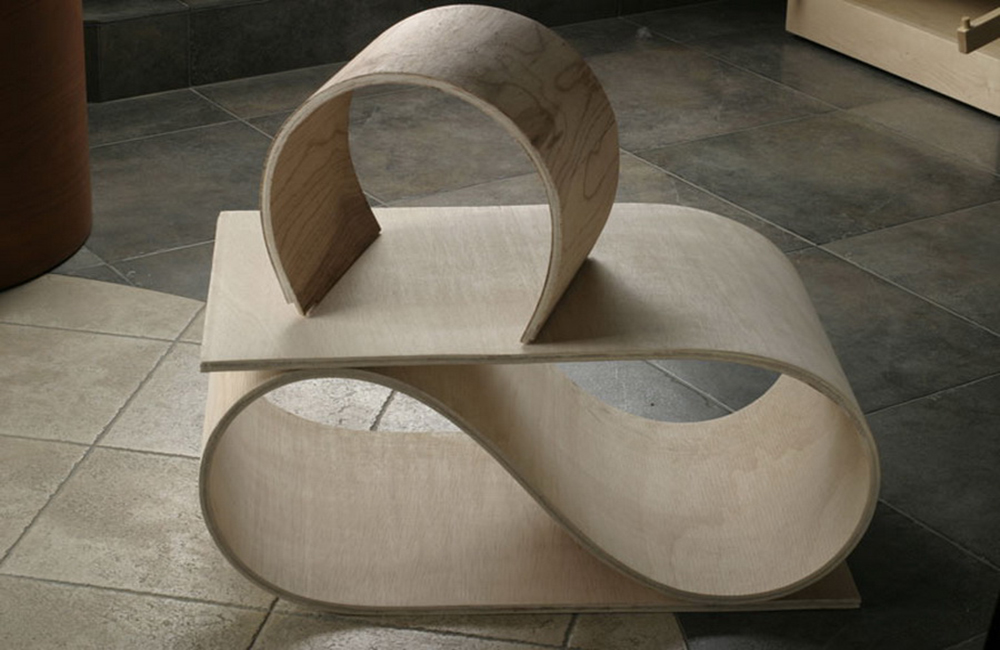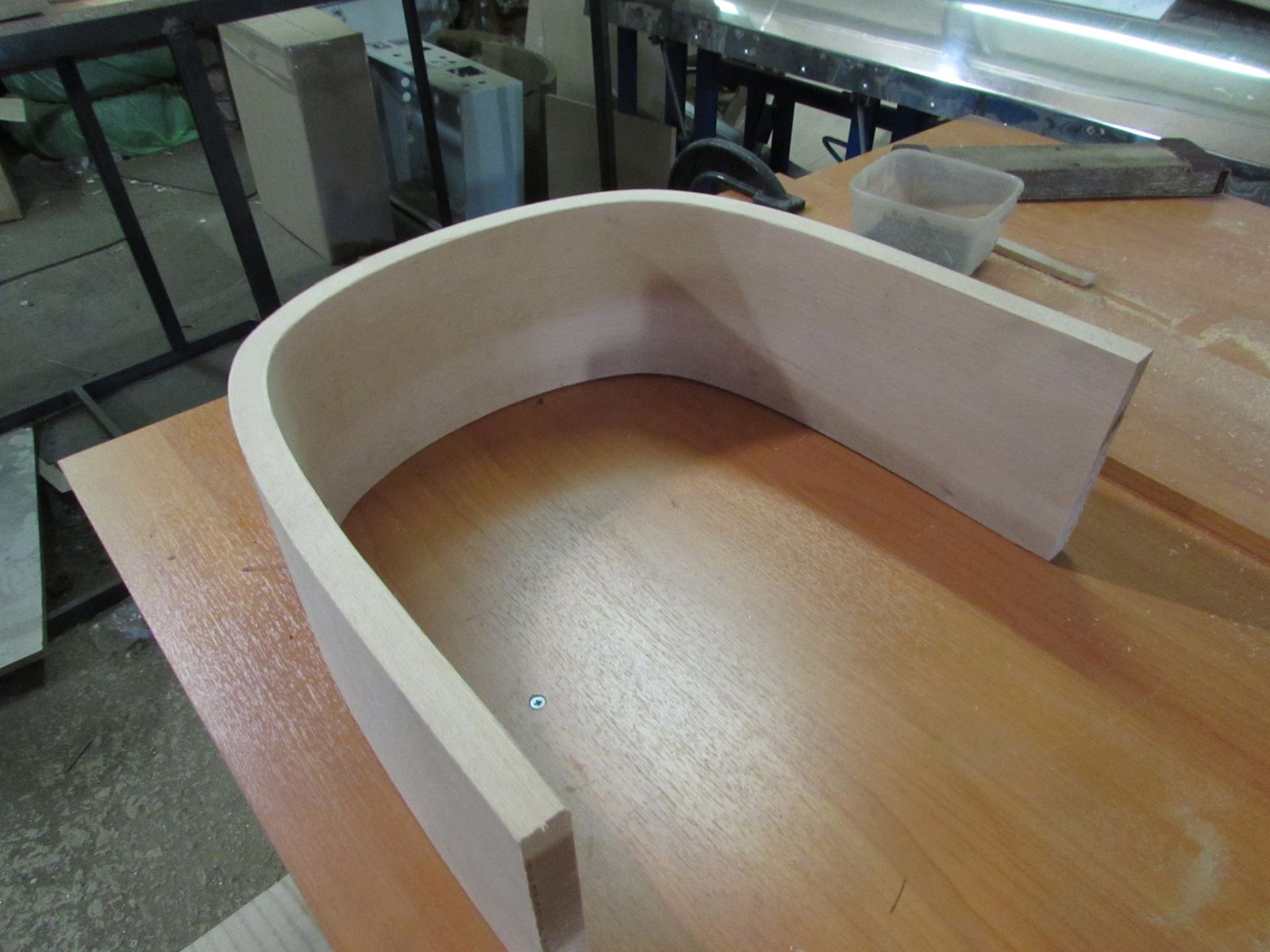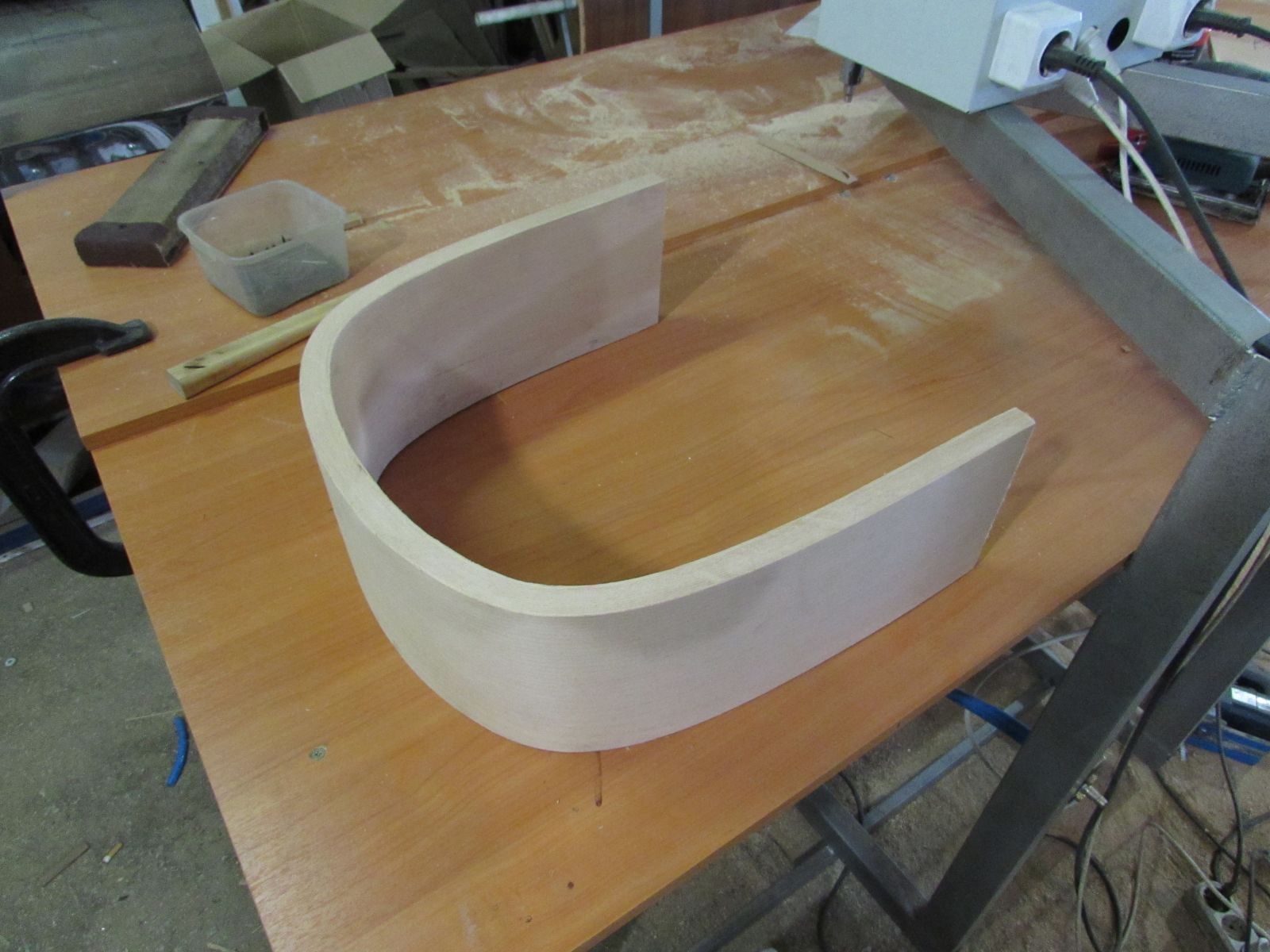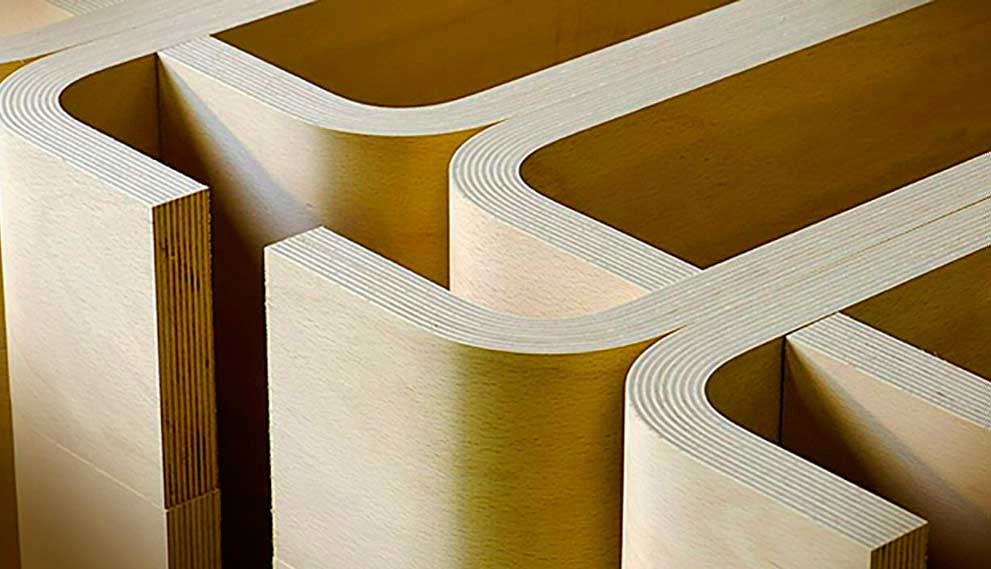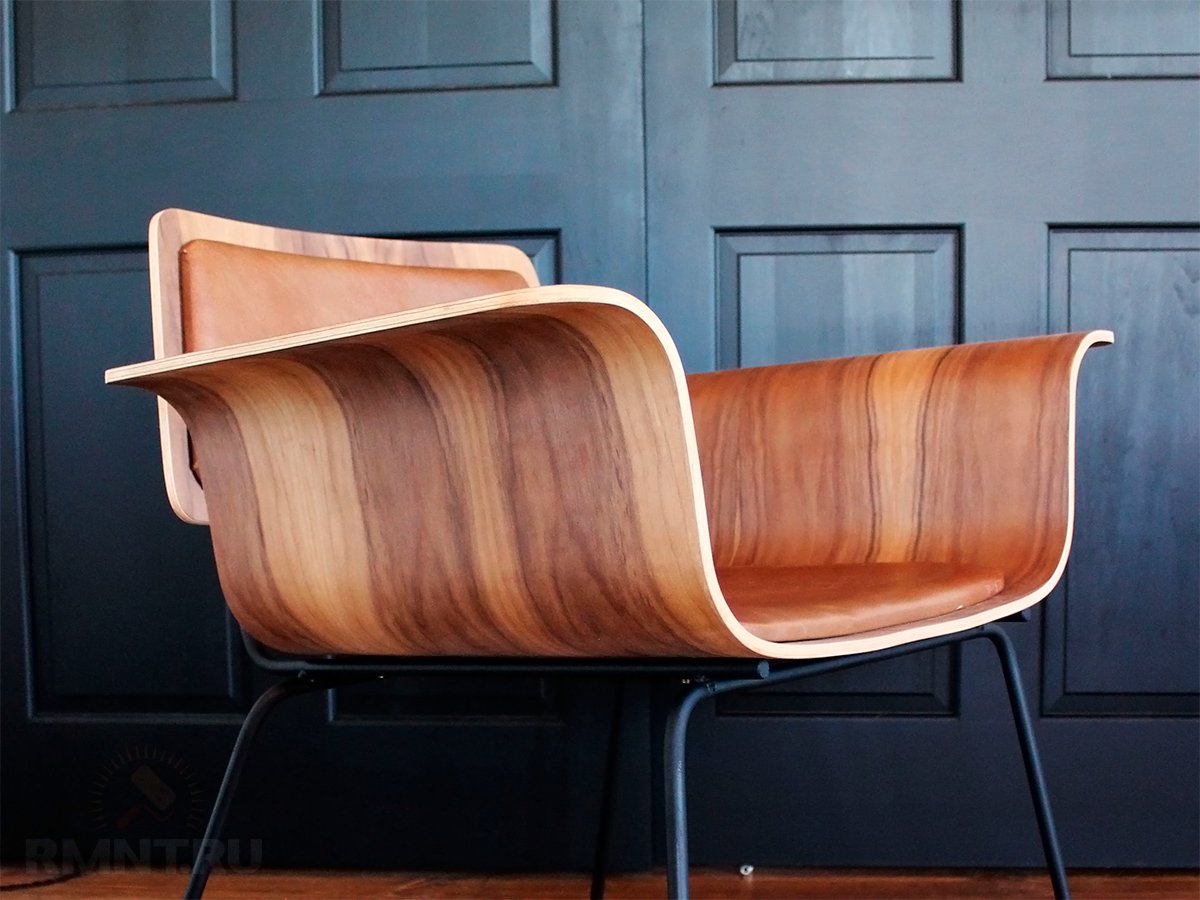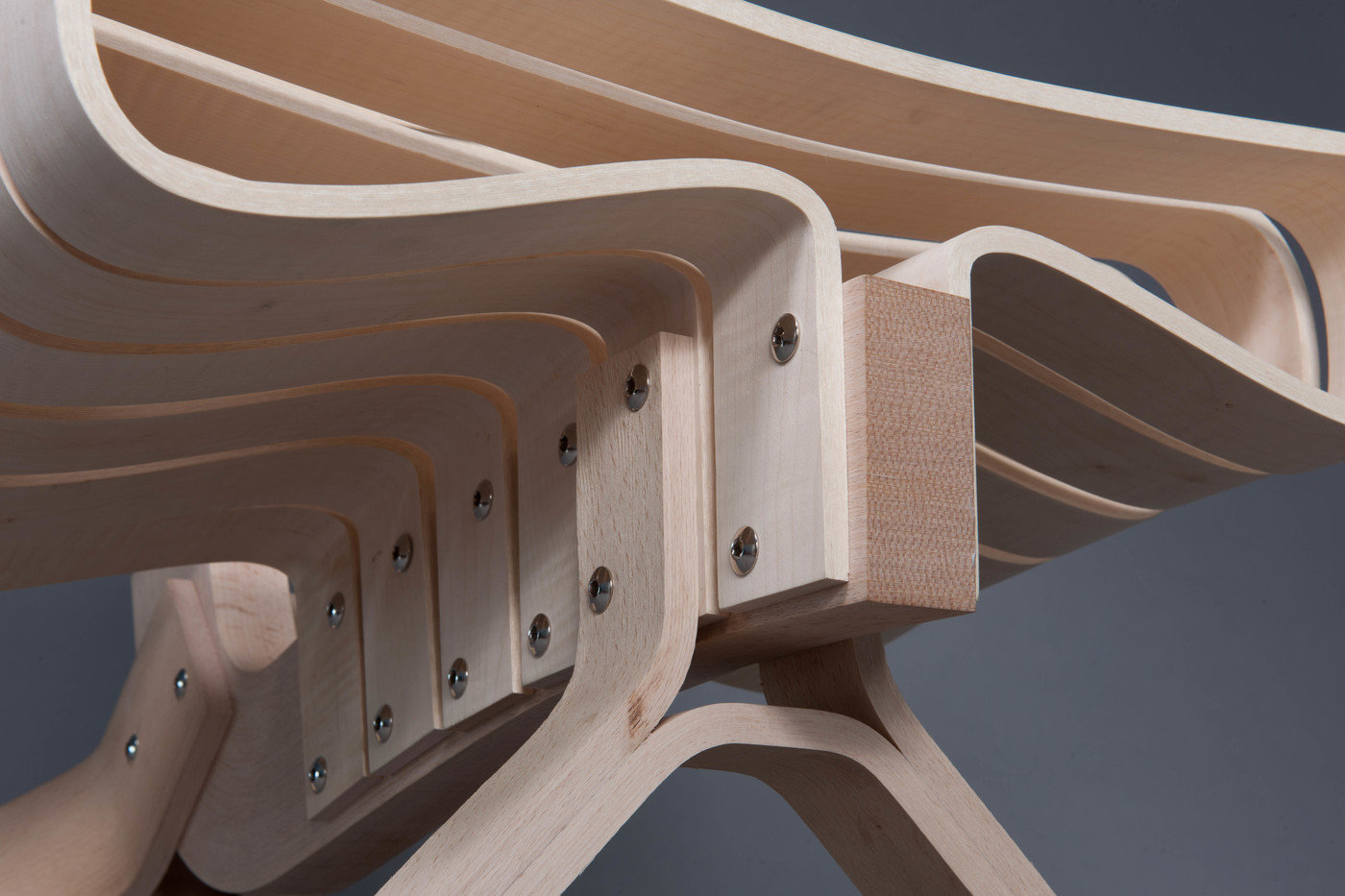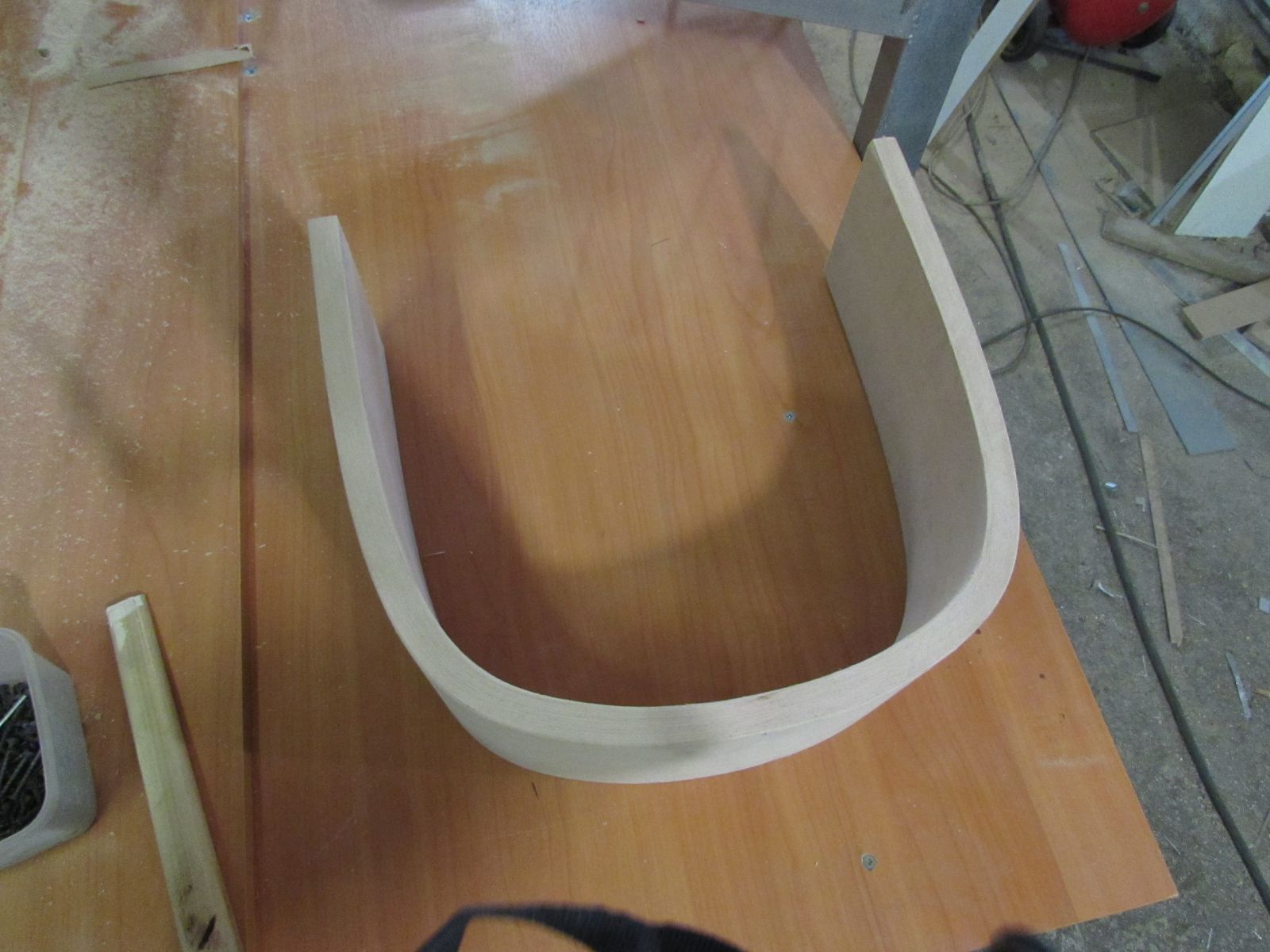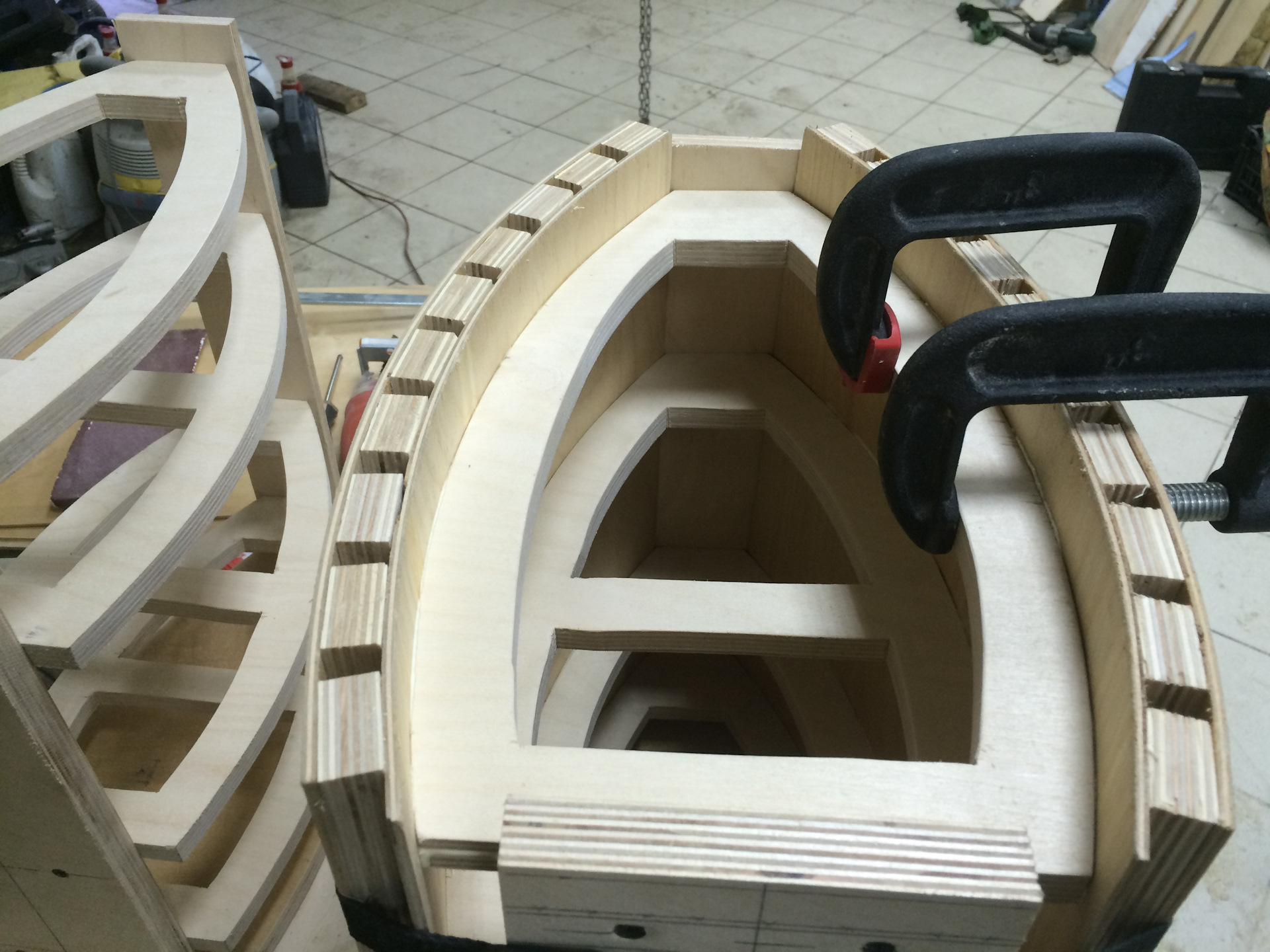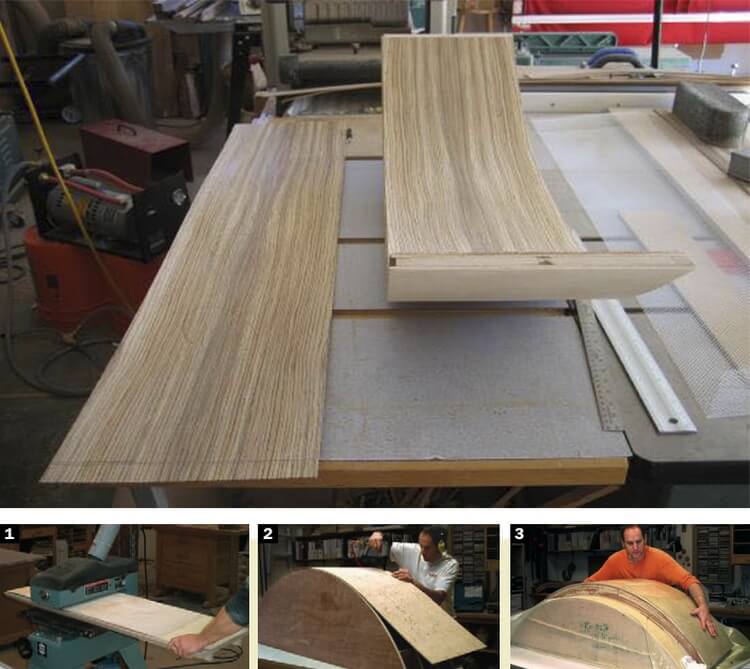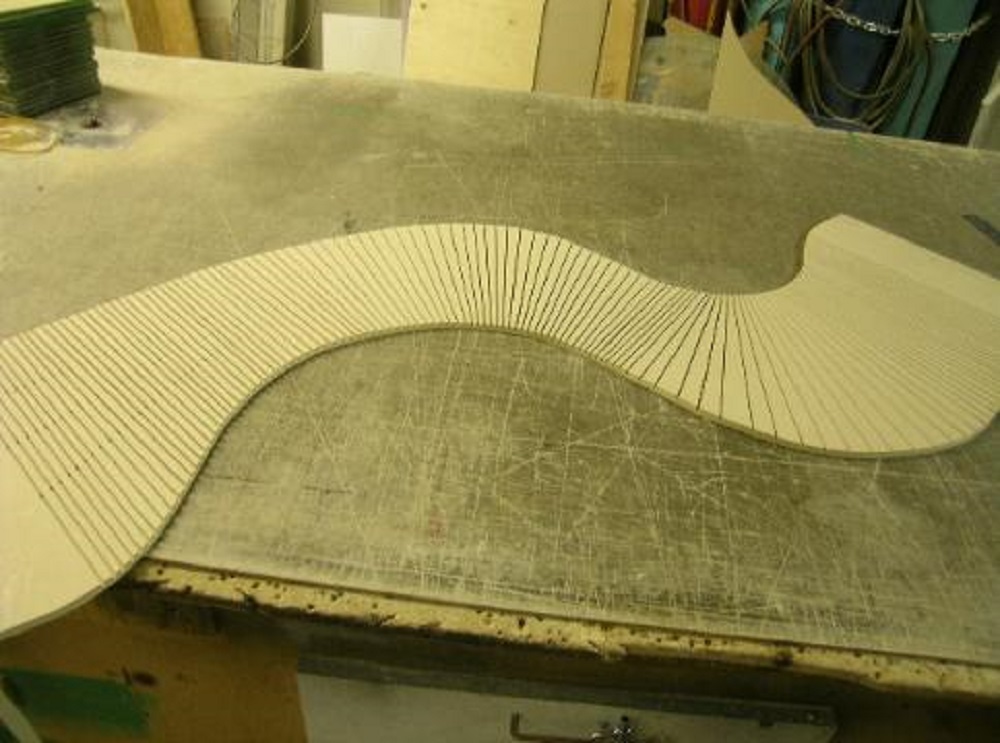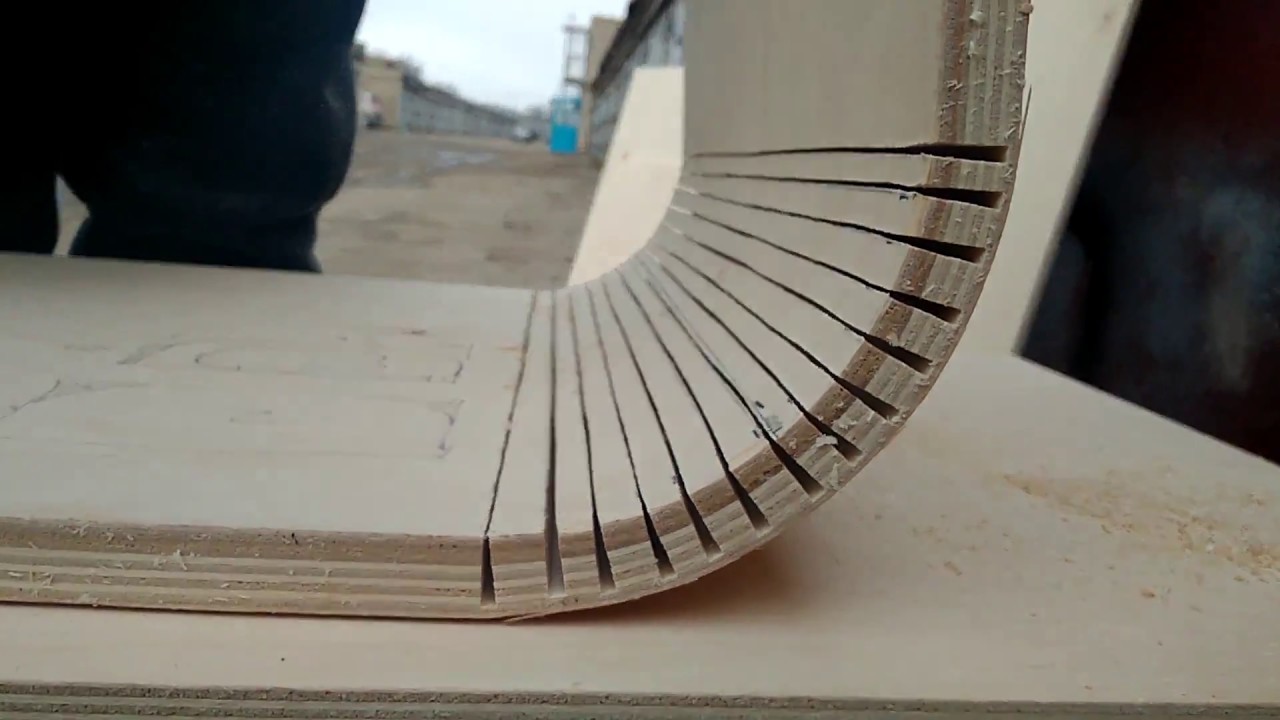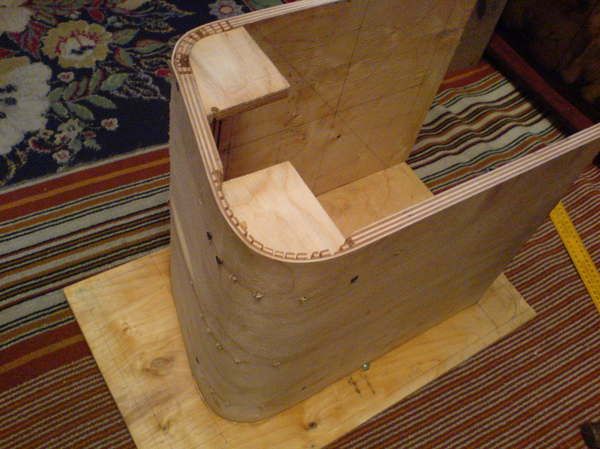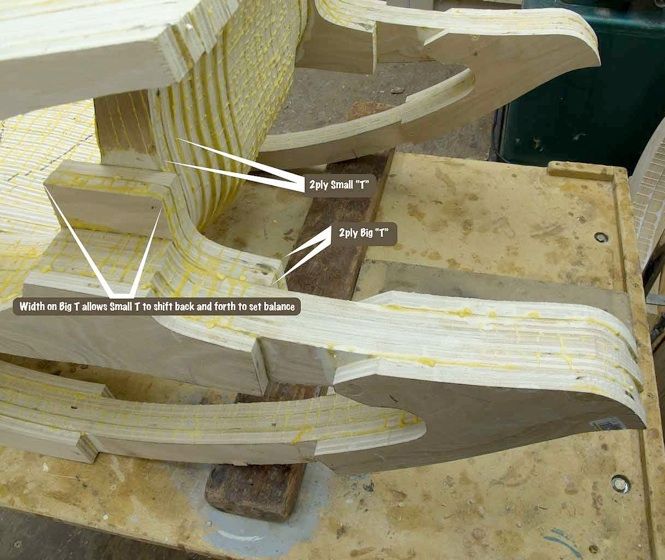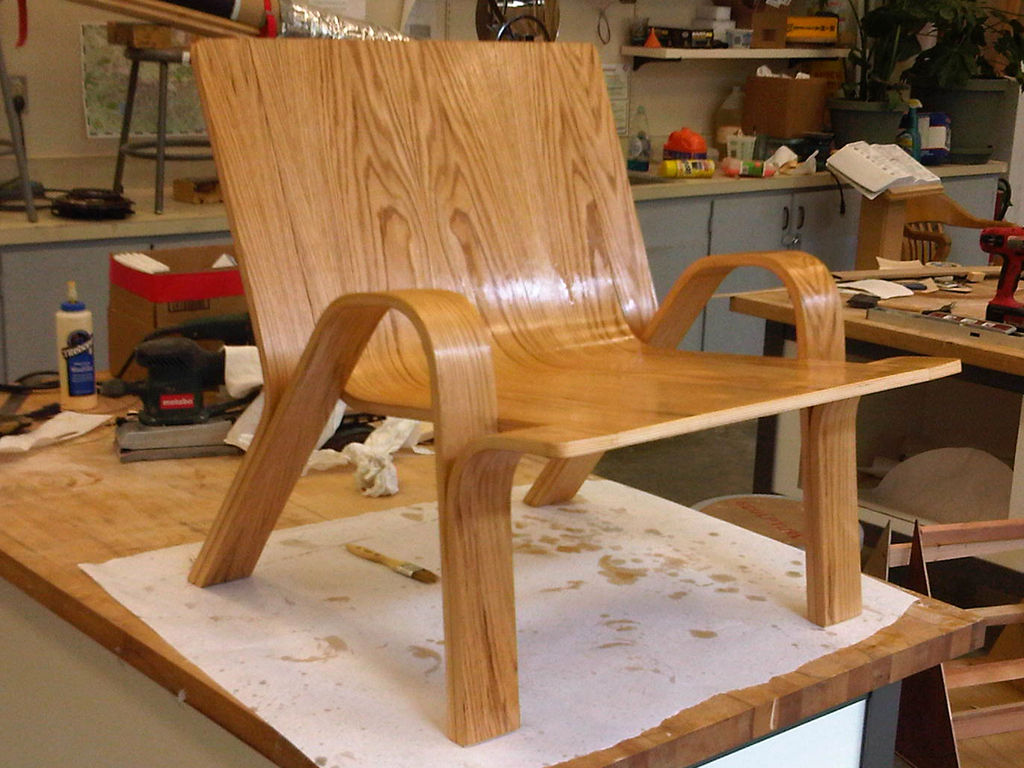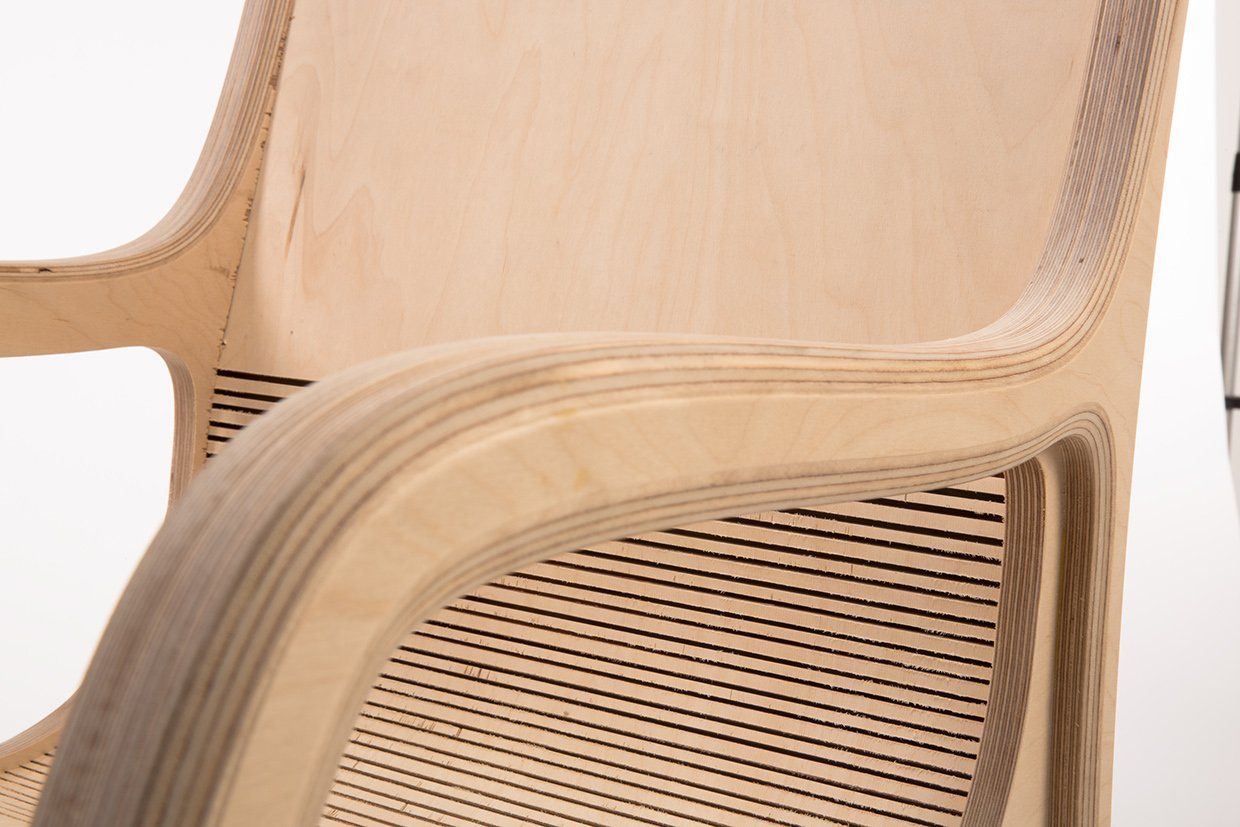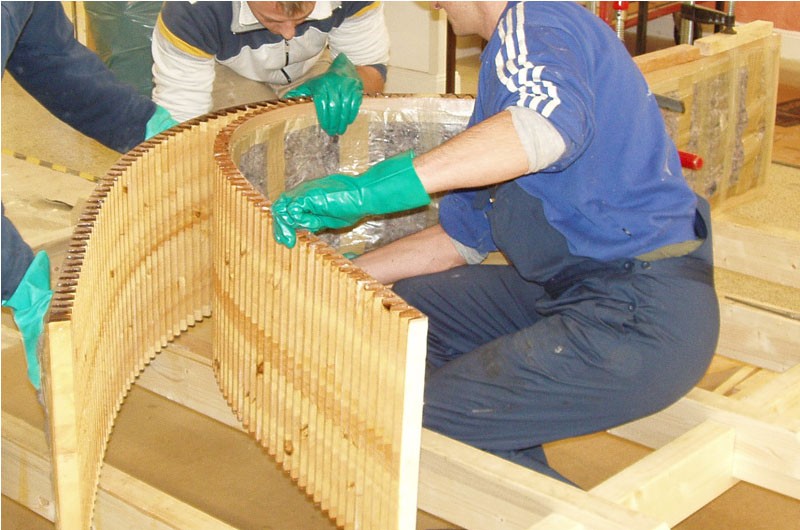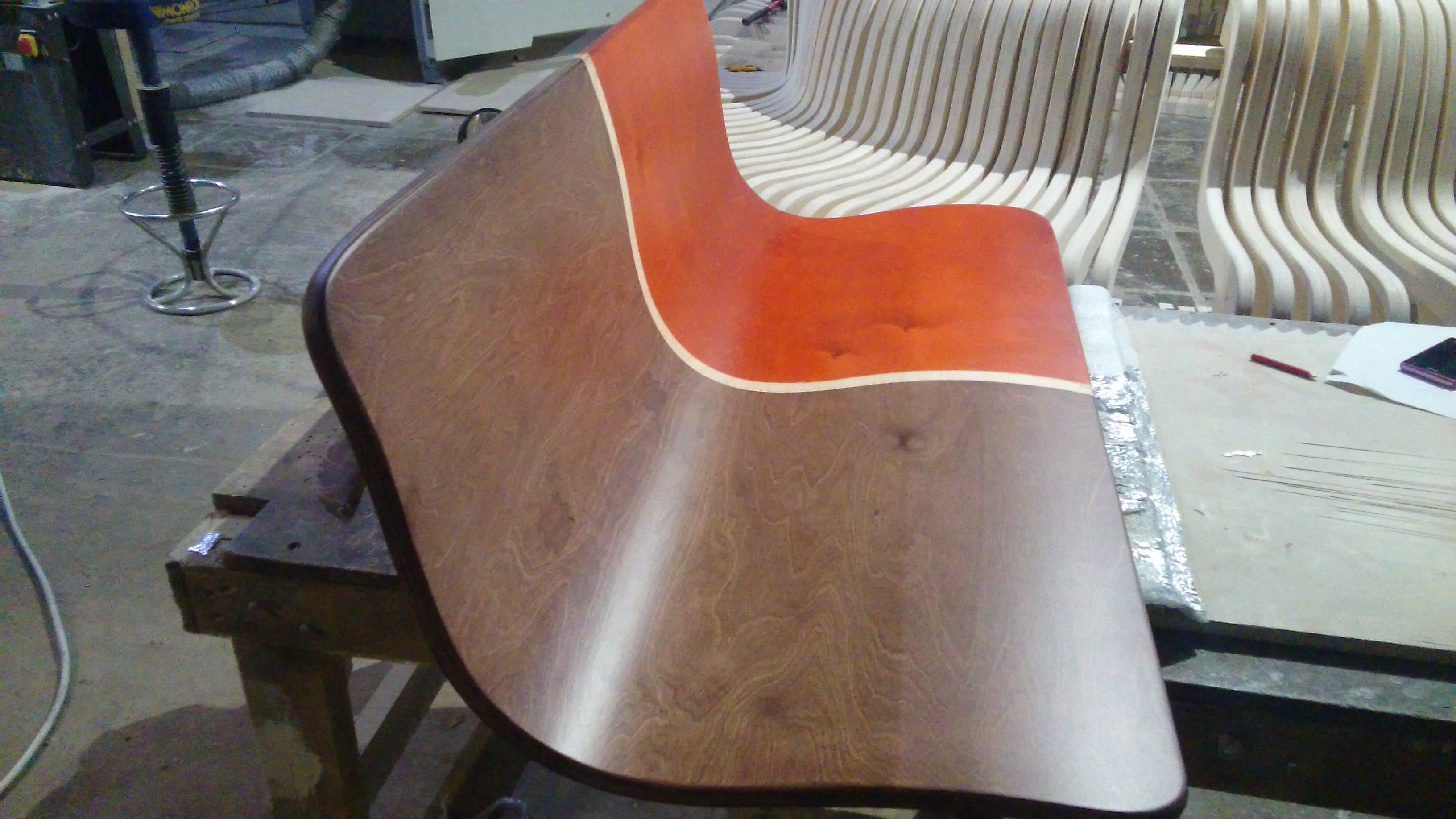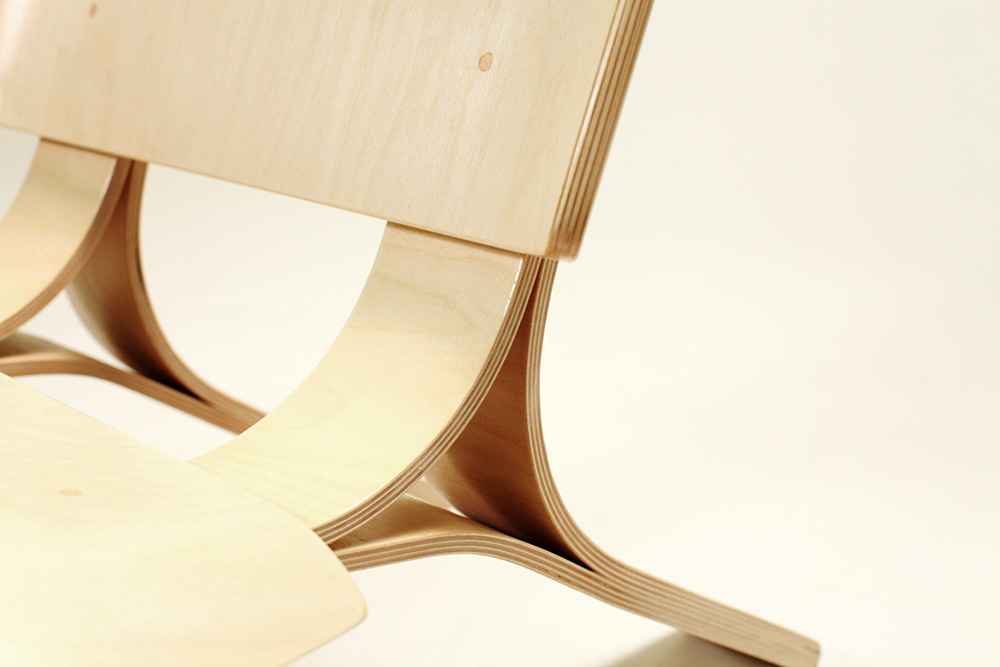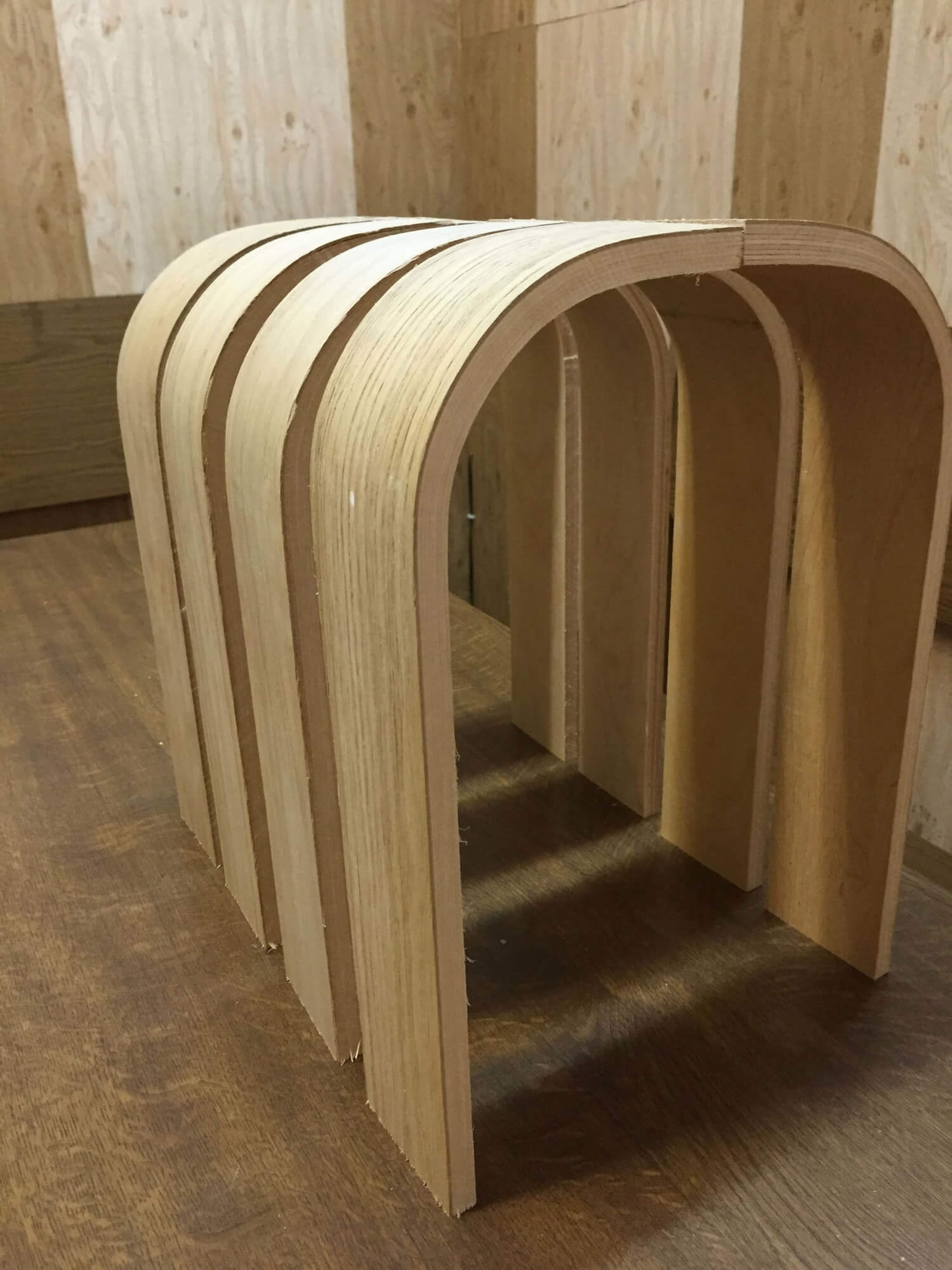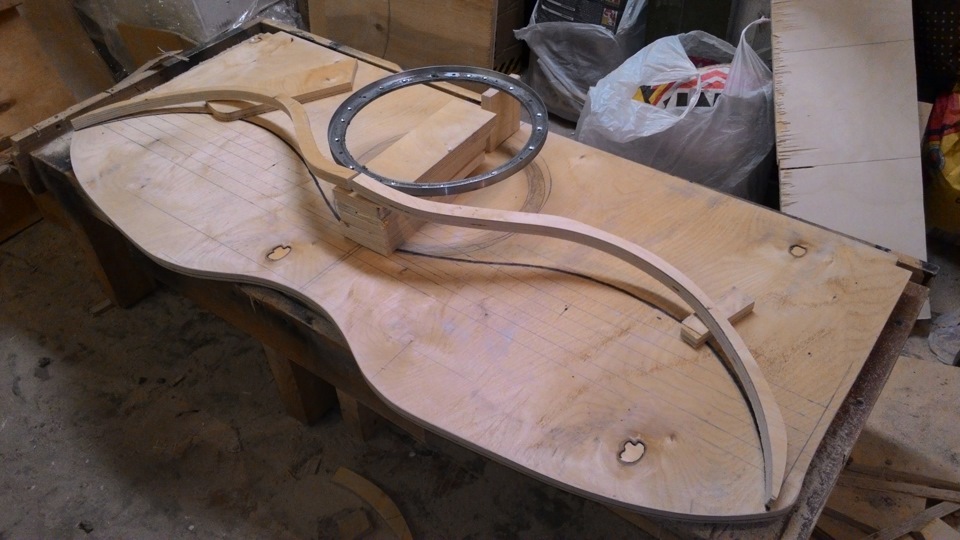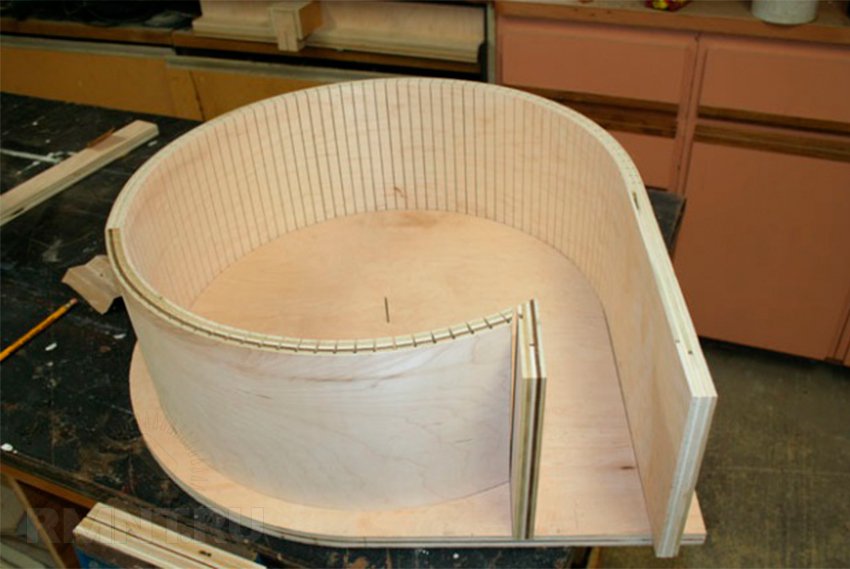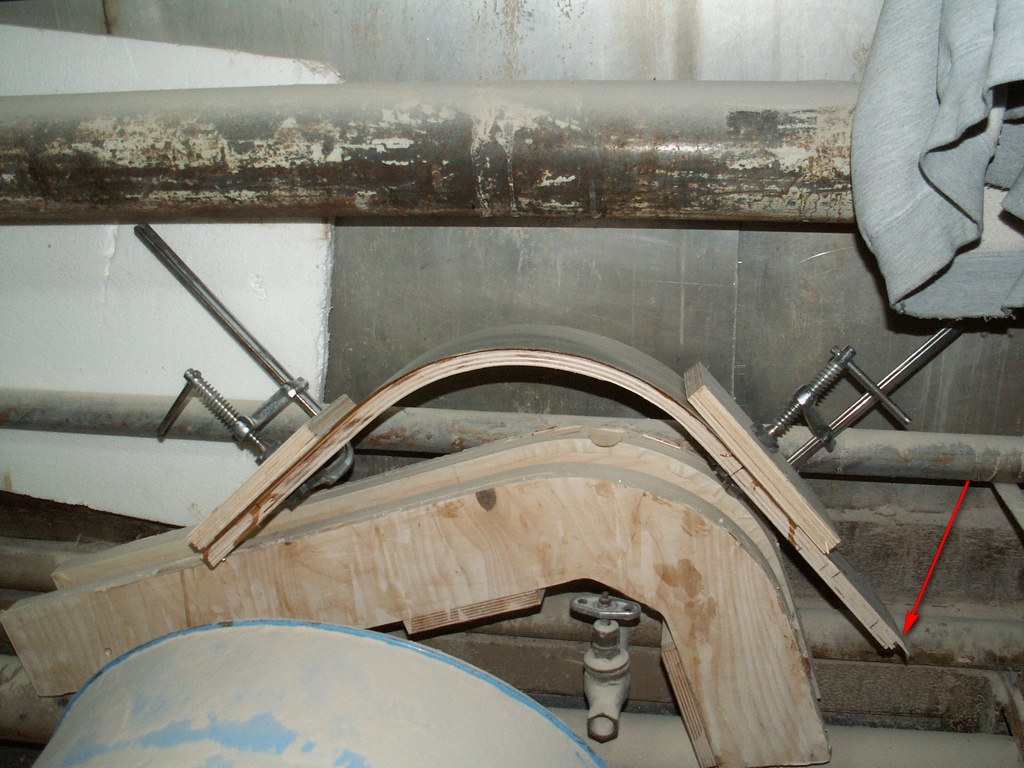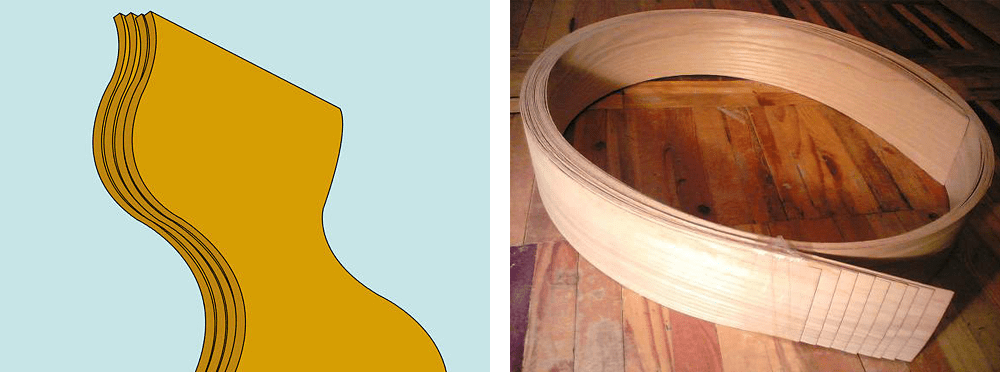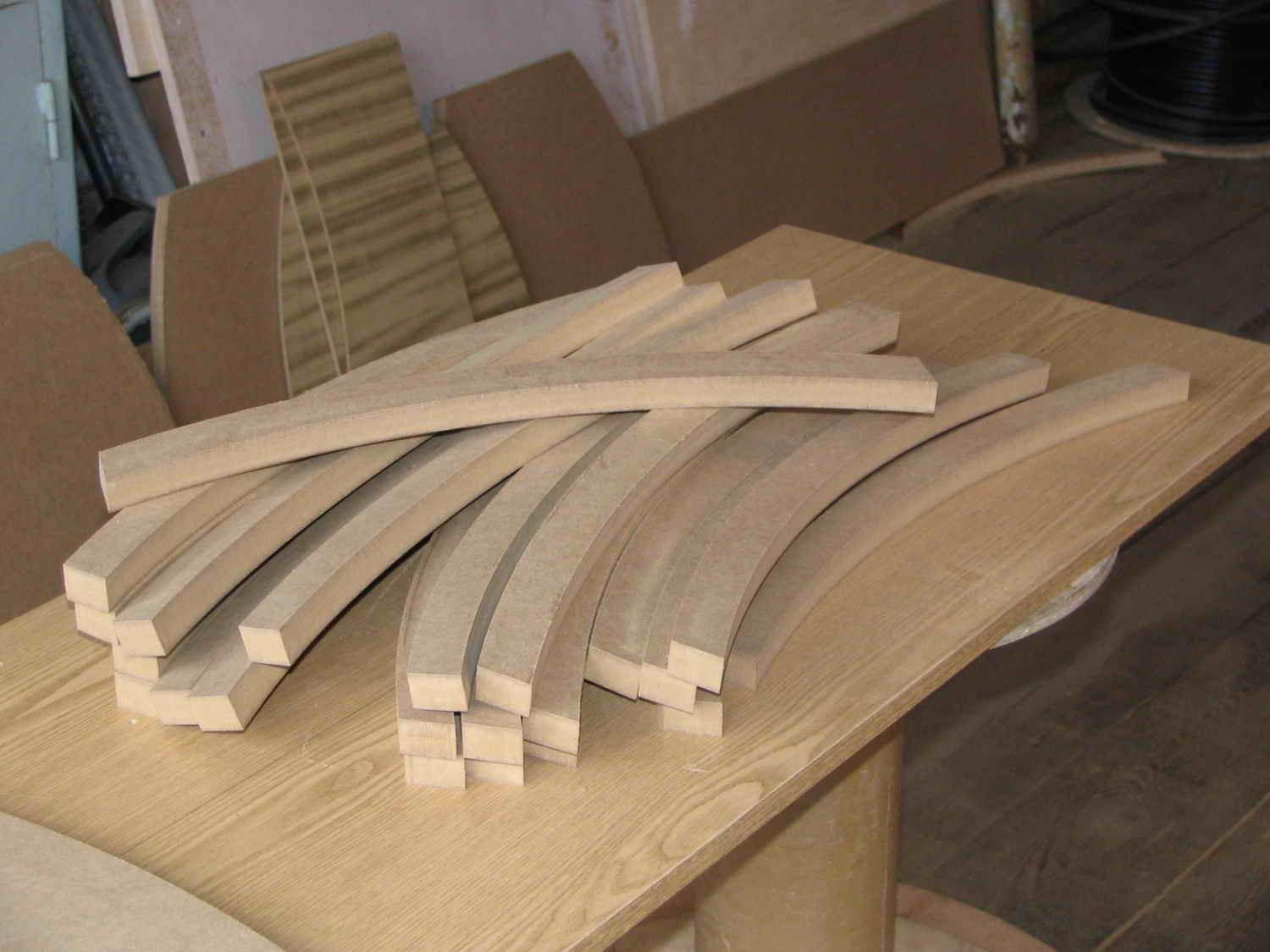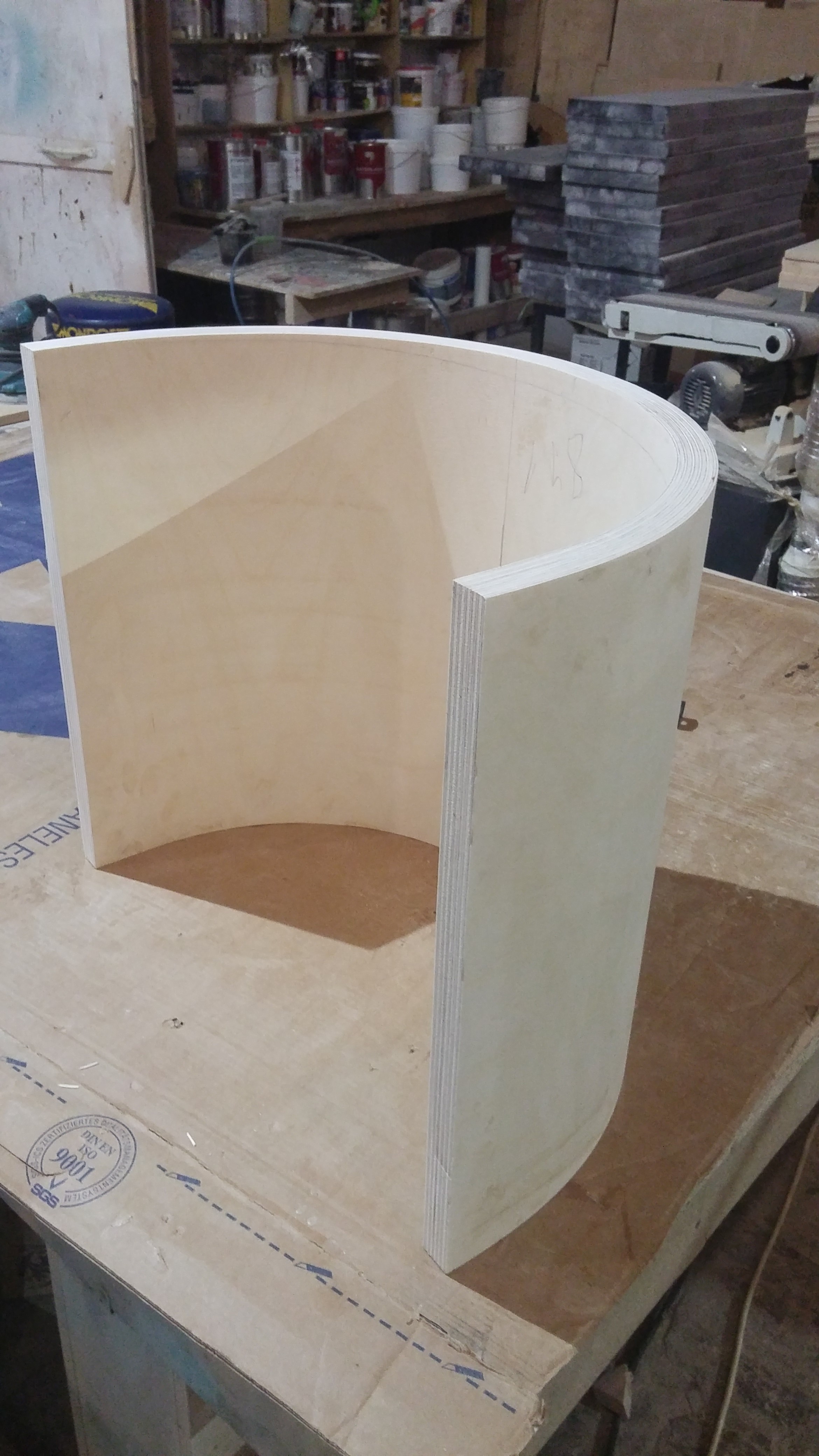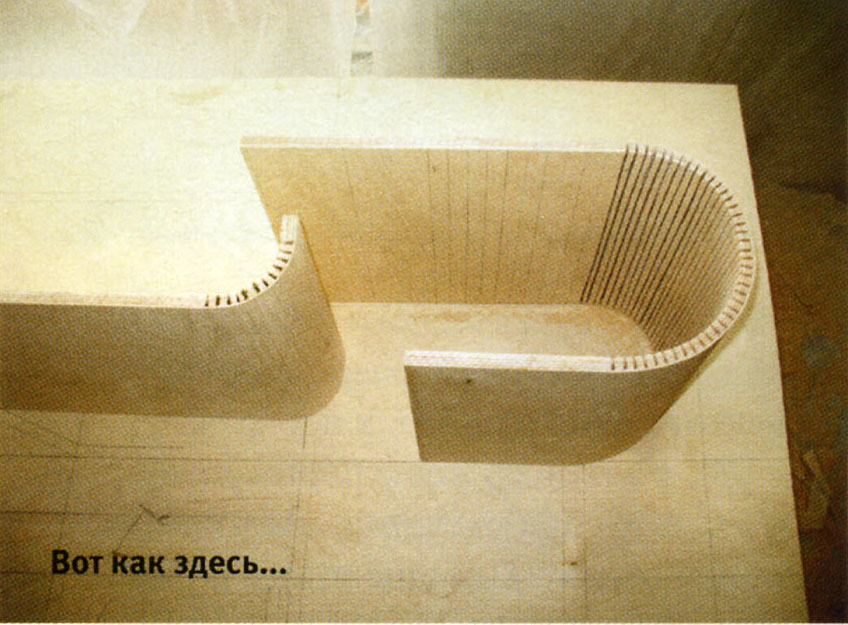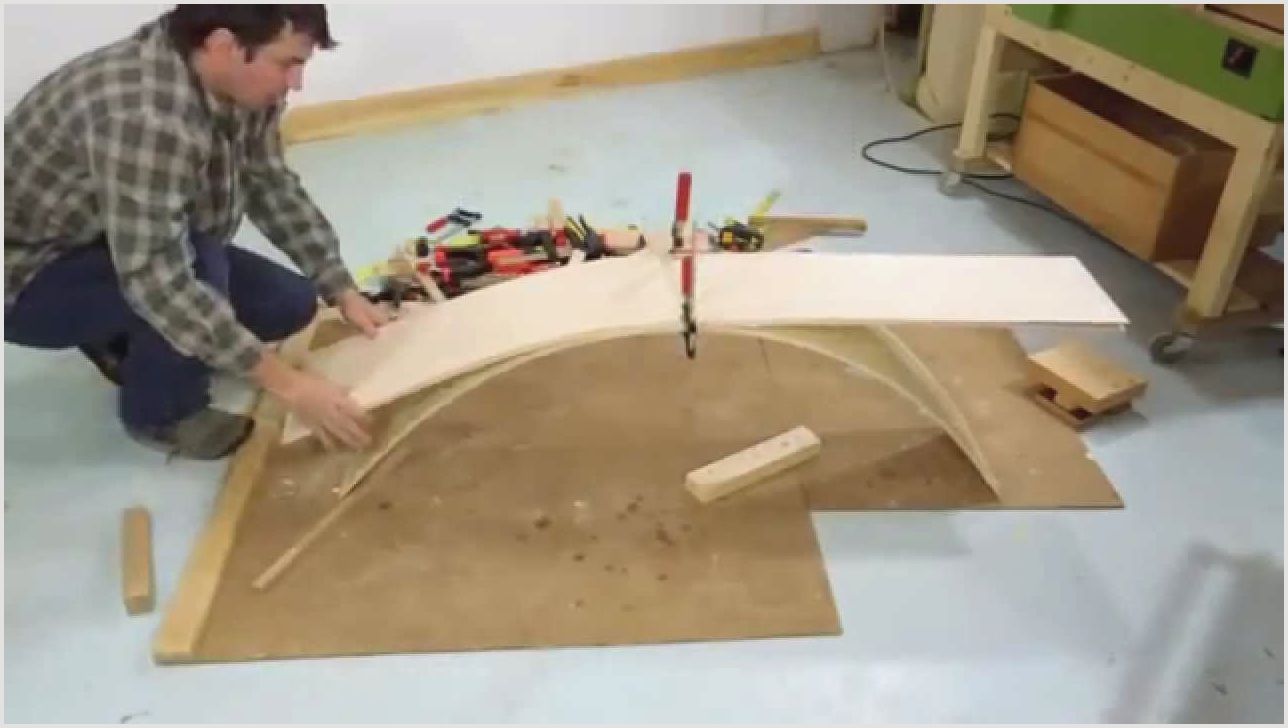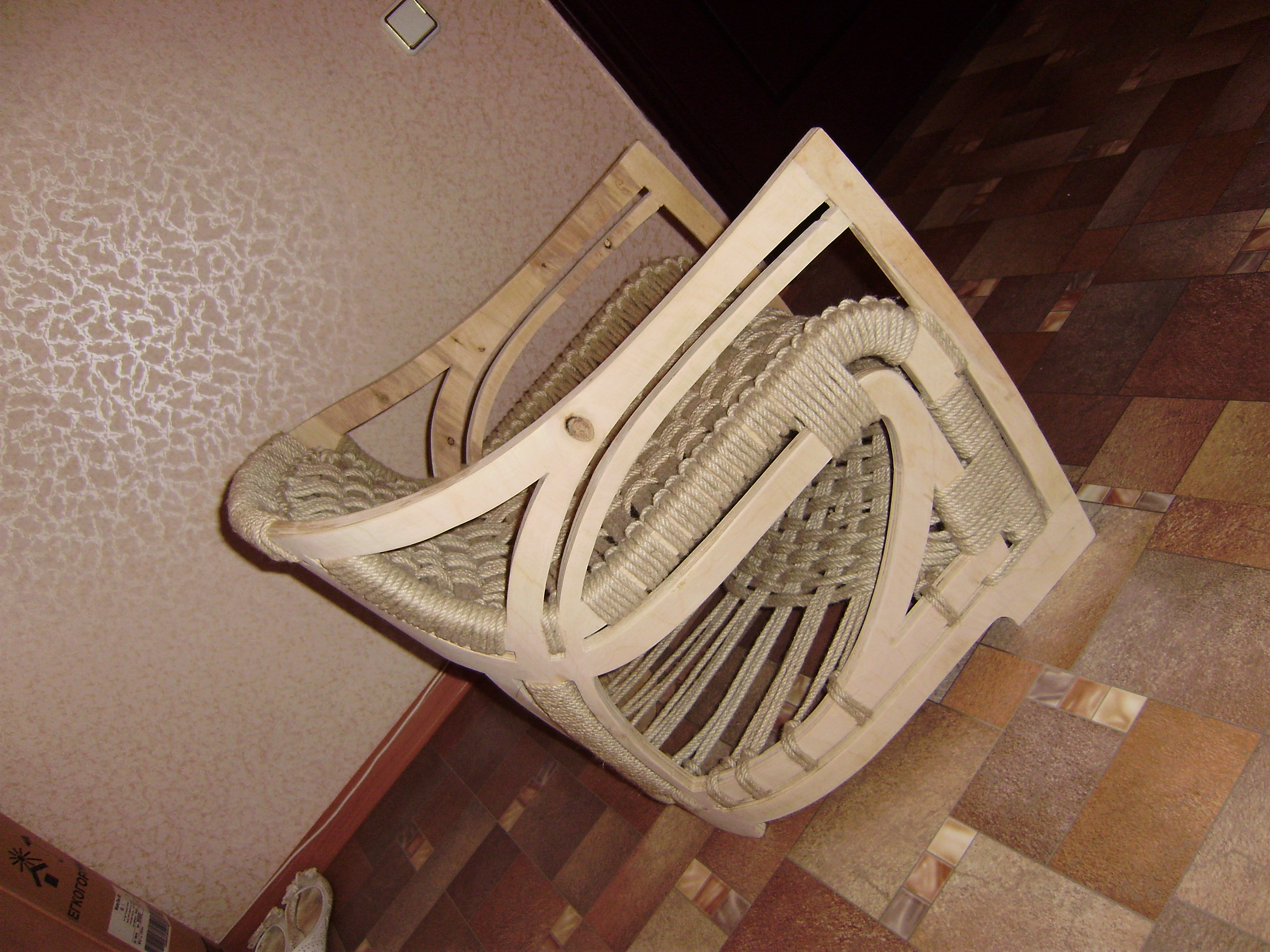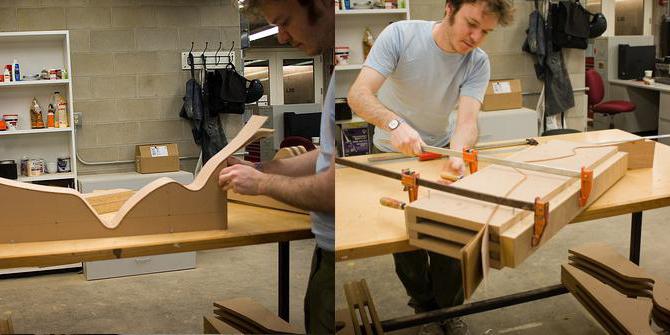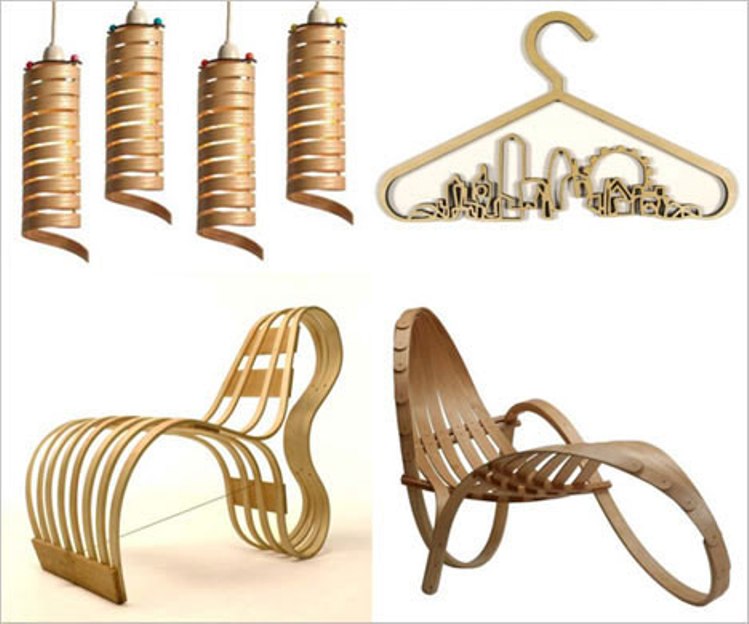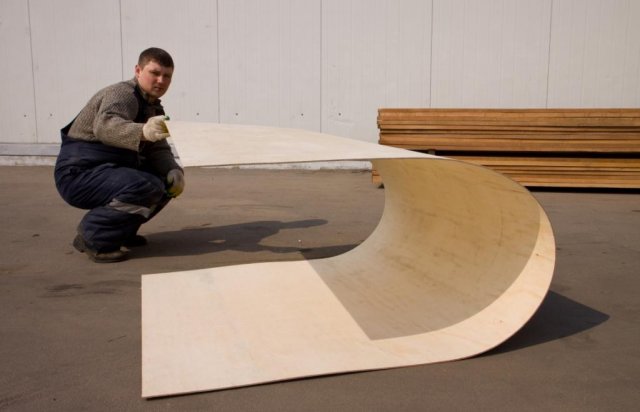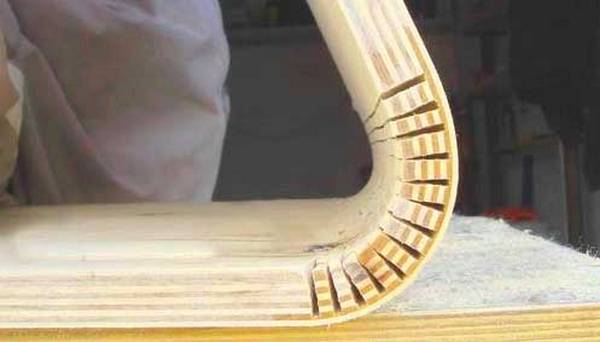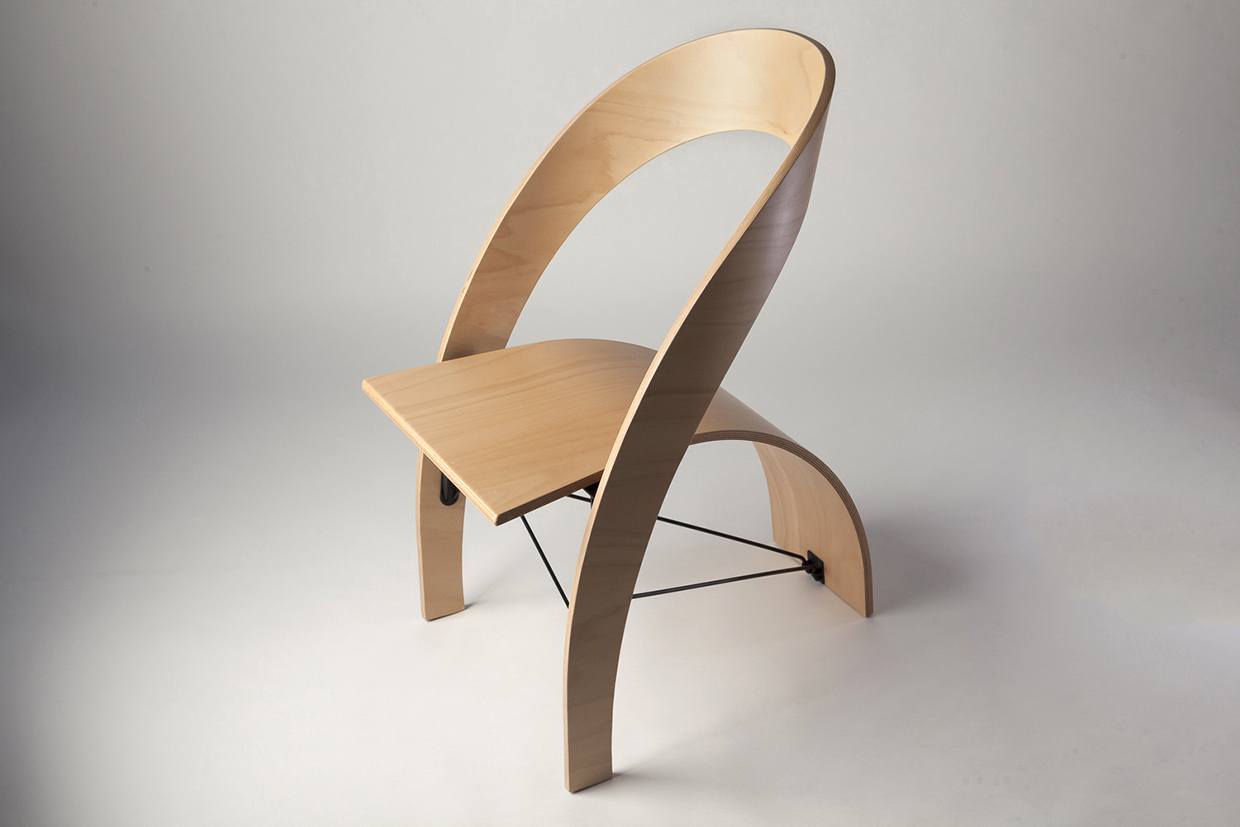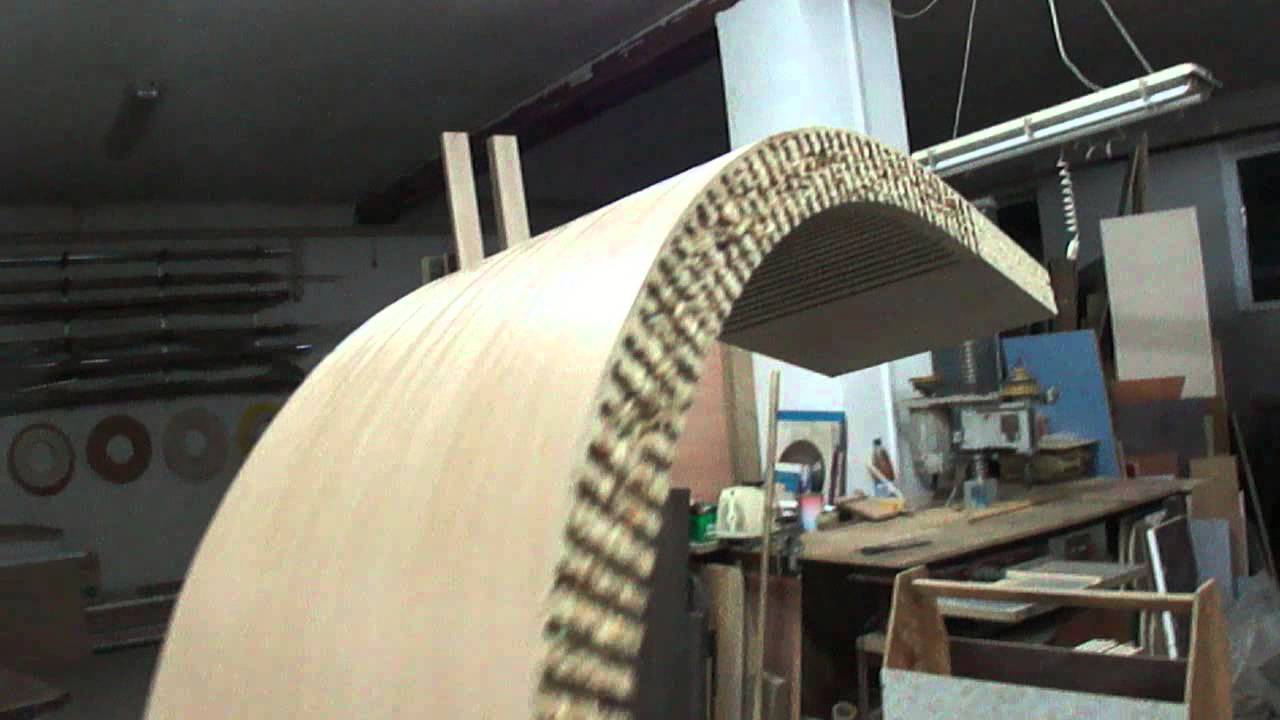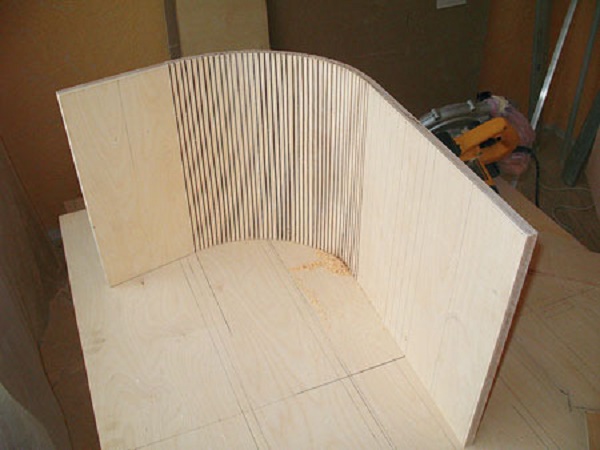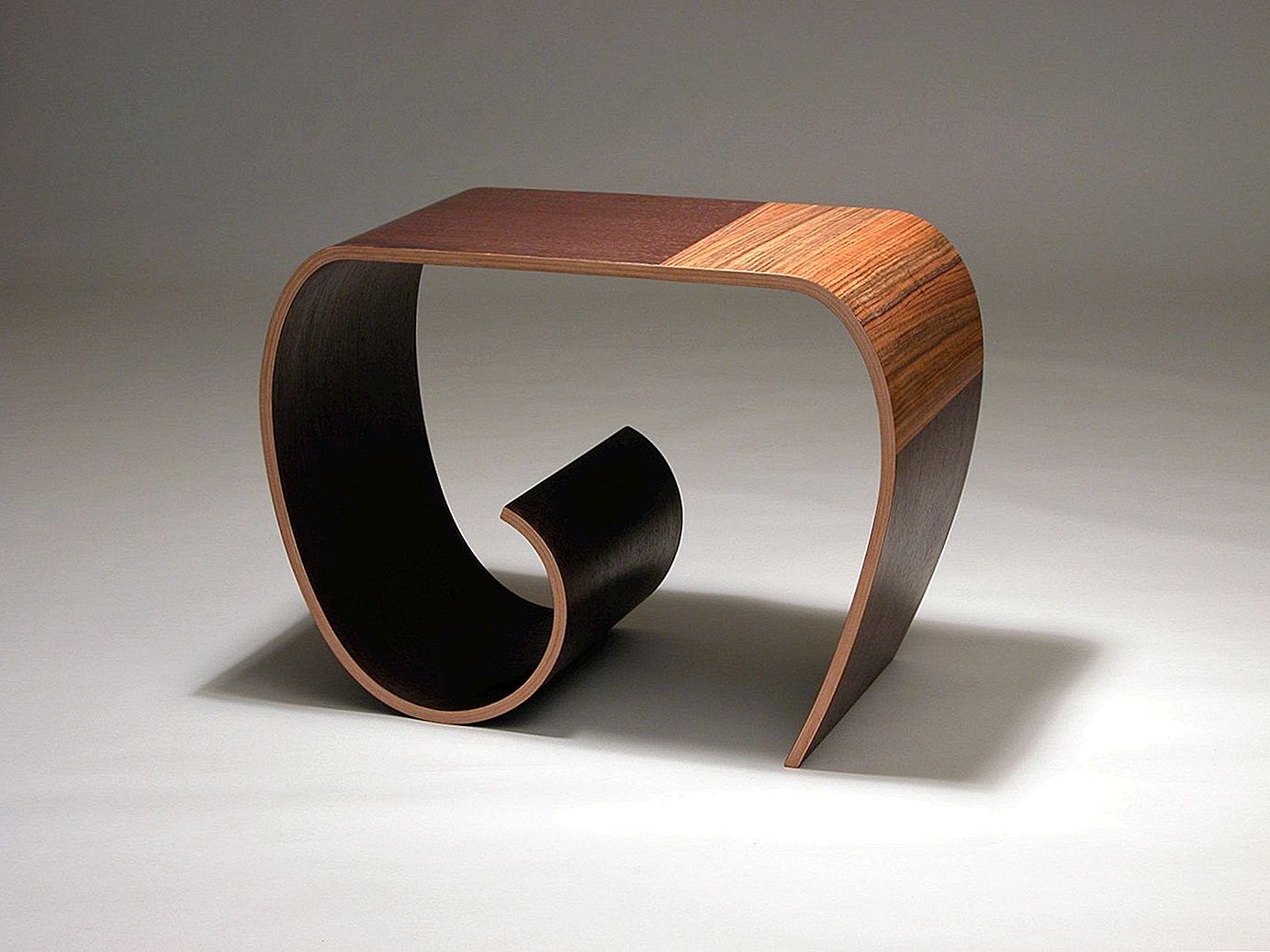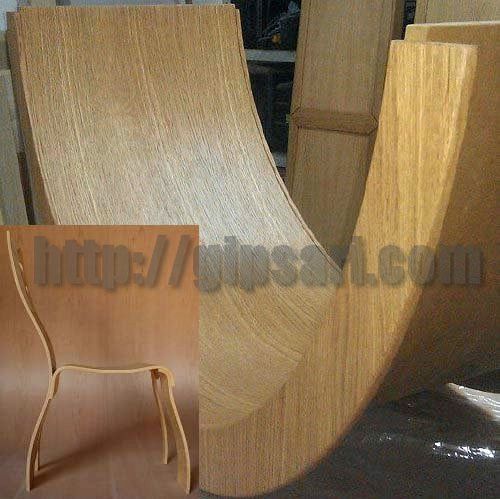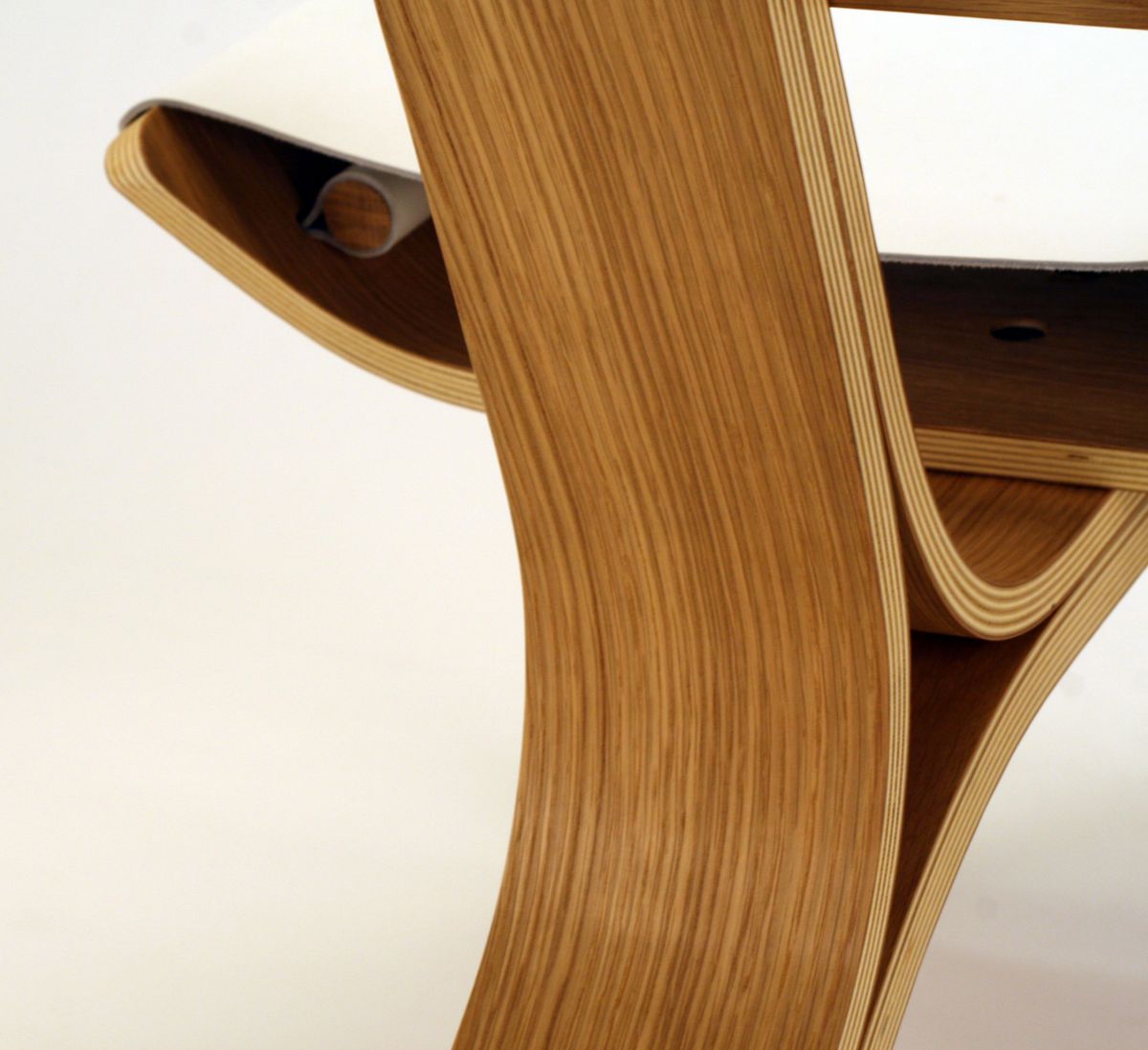Methods for obtaining bending plywood
There are several proven ways to bend plywood material. However, with different options for obtaining a bend, some points must be taken into account. In the case when an arch is required, plywood is chosen with a thickness of at least 10 mm. And this is already a rather thick puff. Hence, we can conclude that the thinner the material, the easier it is to act on it, and, as a result, the plywood is easier to bend.
Today, there are three main methods to bend a plywood sheet:
- steaming;
- notching;
- gluing.
Each of the methods is good and effective in its own way. But you can also use a combination, which will ultimately result in more rigid bent structures. Let's try to disassemble each of the three technologies first.
Steaming plywood
In industrial production, the method of steaming is often used to obtain bending of plywood. It consists in acting on the raw material with steam, after which the plywood is placed in an installation, where a press is fed to it. Under the influence of a special vice, the material is bent to the desired radius of curvature.
At home, it will be more difficult to carry out the steaming procedure. This will require the presence of very large containers in which water should boil. In this case, plywood is simply fixed over the containers, and the steam itself will already do its job.
An alternative to steaming is to soak the plywood sheet in water. It is quite possible to use a bath for this. However, there are also some nuances here.
Firstly, the duration of soaking will directly depend on the thickness of the material, as well as on the direction in which you want to bend.
Secondly, the process of soaking plywood in warmer water will last much faster. So, for example, at a water temperature of up to 90-100 degrees, the soaking time can be 1.5-3 hours, at a water temperature of up to 60 degrees, it is almost twice as long, in cool water (15-30 degrees) even longer - 15- 20 times.
When the steaming or soaking time has been kept for as long as necessary, the plywood can be bent, but only across the grain. To do this, the workpiece is attached to the template, fixed in the desired position and waiting for the material to dry completely. It will be much more effective to combine both methods.
Plywood cut
This method also helps to achieve the desired curvature of the sheet. Moreover, the thickness of plywood can be from 15 to 20 mm. The bending method is as follows: in those places where bending is planned, small cuts are made using a cutter. The cuts must be no more than half the thickness of the sheet, otherwise the material may simply break.
It is also important that the cuts do not reach the opposite direction of the keyway.
The width of the cuts on different sides of the plywood can be different. This allows you to get such a result - on the one hand, the bending angle is smaller, on the other - more. Many people use this technique to bend plywood to form boat walls. And in order to fix the resulting shape, the plywood is clamped and a layer of veneer is glued on top.
In this case, epoxy glue is used, although it is quite possible to do with PVA glue.
Bonding parts
This method consists in taking a thin sheet of plywood and cutting it into separate pieces. A pattern is made and the elements are already connected along it to obtain the desired shape. To do this, epoxy glue is applied to the joints, the parts are glued together and fixed. Clamps can be used to clamp the gluing points. The finished product should dry for about a day, after which it can be used.So that the joining points and irregularities are not visible on the workpiece, it is subjected to grinding.
Few people know that plywood bending is a very common operation in joinery, even fewer craftsmen are familiar with the correct technique. We propose to consider the features of this material and its bending behavior, as well as the basic techniques and devices for bending plywood at home.
Equipment
And so, a number of installations are used to change the shape of the wooden blank and its final preparation before assembly. Bending, as mentioned above, is carried out using special presses, and finishing is carried out on a 5-axis woodworking center. The choice of this equipment is very wide, so we decided that in this case we should focus on the equipment that leading furniture companies use in their production. For example, the world famous IKEA.
The Swedish-Dutch firm, as it turned out, works on Bulgarian machines. For the manufacture of radius products, its specialists use the VChG-40 high-frequency generator in conjunction with hydraulic cold press VP-C 11/15
.
The first device is designed to heat the adhesive layer when working with multilayer workpieces. The installation is distinguished by high productivity due to uniform heating of all layers (even if the thickness of the product exceeds 30 mm). The generator has a stepless power control depending on the production cycle. To achieve optimal values, the entire process is controlled by an ammeter and a thermostat.
After the high-frequency generator heats up the workpiece to the desired degree, the press for bent-glued products comes into play. In high temperature conditions, it changes the shape of the part under the influence of pressure. There are different ways to accomplish this task. VP-C 11/15 crimps the most common - pneumatic chambers with the simultaneous use of special presses. By the way, the choice of "Ikea" in favor of this model is due to a whole range of its advantages over analogues. Firstly, the accuracy of the installation with a force of 100 tons is regulated by a pressure gauge with a timer. Secondly, the press makes little noise. Thirdly, the machine is reliable, has a long service life and complies with CE safety standards.
After 20-40 days after the molding work (namely, after this time, complete stabilization of the radius part occurs), the bent-glued product is subjected to finishing. This work is carried out at a five-axis woodworking center. The most suitable option is setting SPIN
Is one of the latest developments of the Italian manufacturer of high-tech equipment PADE.
 According to Italian experts, in just 224 seconds, it solves a whole series of tasks in a minimum amount of time. This is profiling of absolutely identical radius parts of any complexity, filing into the corner of the ends, drilling holes for a dowel, filing to size in width, making a groove for a panel or glass, etc. In total, in one cycle you can get from 2 to 4 completely finished curved parts
According to Italian experts, in just 224 seconds, it solves a whole series of tasks in a minimum amount of time. This is profiling of absolutely identical radius parts of any complexity, filing into the corner of the ends, drilling holes for a dowel, filing to size in width, making a groove for a panel or glass, etc. In total, in one cycle you can get from 2 to 4 completely finished curved parts
ready to be assembled into a finished product.
In general, this machining center allows for the production of products with very high precision. Therefore, SPIN is ideal not only for large-scale production, but also for small-scale production of exclusive furniture items.
Wood-laminated panels, which we simply know as plywood, have found their way into the decoration and manufacture of furniture. They have one of the most unique properties and can be used to create almost any bend. Due to this, it becomes possible to create unique aesthetic designs and efficient use of the material.
Now let's talk about how exactly you can make bent plywood
in the industrial production of plywood and independently at home.
Each layer has its own approach
 In a workshop, everything is, of course, easier.
In a workshop, everything is, of course, easier.
In fact, of course, the solution to the question of how to bend plywood is not calculated with an accuracy of the layer, but there is still a certain amount of truth in the title of the chapter. Let us explain: there are a number of difficulties in bending plywood, which are associated precisely with the structure of the material, as well as with the technological features of the bending process.
Namely:
- The thinner the plywood, the easier it is to work with. However, for the sake of objectivity, one must also take into account the fact that to design, for example, arches, plywood must be at least 10 mm, that is, you already need to bend a fairly serious puff (see also the article Do-it-yourself plywood arch - basic techniques) ;
- Initially, the veneer layers are located at different angles to each other precisely in order to increase the material's resistance to bending;
- In the conditions of workshops and special workshops, the bending and the required curvature are achieved quite simply: the part is practically saturated with steam and then comes under the influence of a kind of vice, which bends it to the desired radius of curvature.
All this is real, but there are two points that need to be considered:
- First, wood cools down very quickly, this applies equally to plywood;
- Secondly, it is very difficult to achieve uniform heating of the entire part, therefore this type is suitable for small fragments with bends, most likely for the production of curved surfaces of furniture or other small products.
How to bend
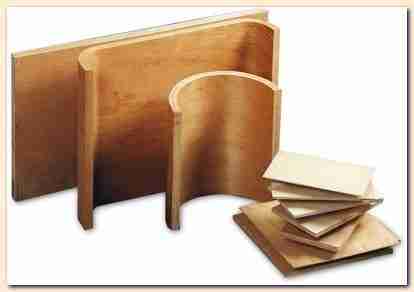 The bend depends on the purpose of the fragment.
The bend depends on the purpose of the fragment.
So how do you fold plywood without the hassle?
There are two main technologies:
- Ferry (which has already been described);
- In the bathroom with hot water.
The second technology is much simpler, it allows you to calmly put the necessary fragment in the bathroom, or another sufficiently large container and leave it in hot water for half an hour. The effect will be guaranteed, since the wood veneer softens under the influence of water and temperature, and the plywood part acquires the necessary elasticity.
Take a strip of plywood of the required thickness and soak it in the bathroom. Check the state of the fragment every 5 minutes for bending, if after a certain time (within half an hour) the fragment bends normally, then this is enough time to soak the entire working fragment.
The softened part can be installed in a stationary place, attached with self-tapping screws and left to dry completely, this is the case if you are making a false column, a simple arch or other part that does not require additional complex structural inserts.
A few words about complex structures
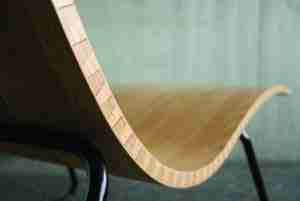 Bending is a delicate matter.
Bending is a delicate matter.
The arch of the arch is different, as is the curvilinear structure of another curved structure. Home craftsmen often resort to complex, combined solutions using overhead ornaments and other decorative elements. In this case, the entire structure is assembled into a single ensemble, and only then it is mounted and reinforced in a stationary place.
The material is soaked, bent as far as possible, then left to dry completely. Then everything is repeated again until the part acquires the intended curvature. 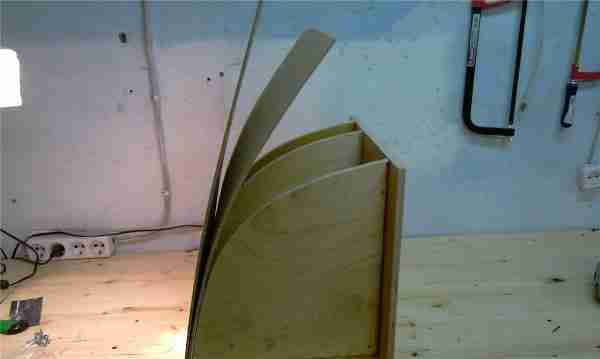 Fastening to templates.
Fastening to templates.
There are several basic techniques for securing workpieces after soaking.
We will not repeat all of them, we will focus only on the one that we consider the most acceptable for the following reasons:
- If you do not install the workpiece directly to a stationary place, then you need an accurate, even bend and a combined solution;
- The maximum winning result can be provided only by a previously prepared blank or template;
- The fixation on the template is guaranteed to save you from the need to redo or fix a part.
In this case, we are talking specifically about fixing the fragment on the template until it dries completely.Making the template itself is quite simple, by the way, there are also a lot of manufacturing options.
Here is one of them:
- Take wooden slats with a length equal to the length of the part;
- Cut out several fragments from chipboard or wood (from 3 or more, depending on the length of the bent plywood sheet) and fasten them to the slats;
- Fix the plywood puff on the finished frame with self-tapping screws and leave to dry completely.
About working with large sheets
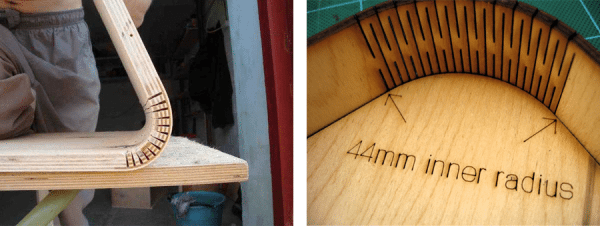 Cutting option.
Cutting option.
Sometimes it becomes necessary to bend a large sheet of plywood with your own hands. This occurs when the design of an arched vault of considerable length or other similar shape.
In this case, the following is done:
The most efficient ways to bend plywood
The most effective method for bending plywood is to use the method of increasing the temperature and humidity. However, in some cases, it is advisable to use the dry method of folding the material. When calculating the time and effort required to change the shape of the material, it should be borne in mind that the thicker the plywood sheet, the more difficult it will be to bend the sheet. Therefore, when choosing a folding method, the thickness of the sheet must be taken into account first. There are several most effective methods for bending plywood yourself.
You can learn how to bend plywood correctly from the video:
Steaming
The steaming method is popular for changing the shape of plywood not only at home, but also in large industries. In this case, the plywood sheet is softened with steam, after which it is given the required shape. On a production scale, this method can be used for sheets of various thicknesses and sizes. Only small sheets can be bent with steam alone.
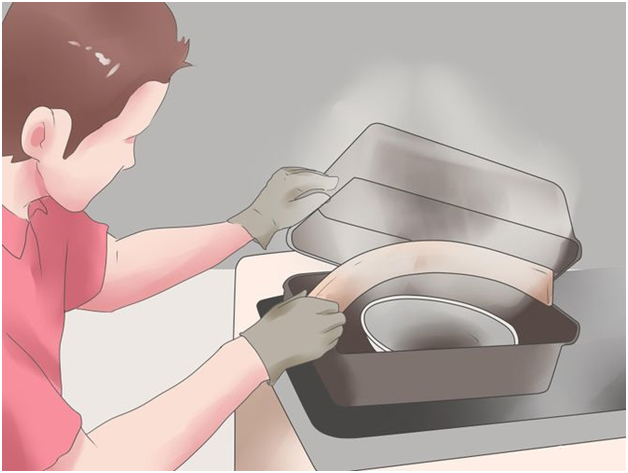 Steaming method
Steaming method
Technologically, the steaming process is the supply of steam directly to the sheet. In production, this process is carried out using a special steam installation. At home, you just need to keep the sheet over a container of boiling water for a while. In case of high material density or low steaming efficiency, you can immerse the material in hot water.
Notching
If the plywood has a high density or large size, the home steaming method will be difficult to use. In this case, you can use the scoring method. In those places where it is necessary to bend the sheet, cuts of a certain depth should be made. This indicator depends on the thickness of the sheet, and should be no more than half of this value. If the cuts are too deep, the workpiece may simply break.
 Plywood cut
Plywood cut
The notch width is determined depending on the angle that should be obtained when bending the material. After making the necessary cuts, the sheet should be placed on a pre-made template, and a veneer sheet should be glued onto it. After that, it is recommended to leave the workpiece for at least a day so that it dries completely.
Gluing
A great way to bend plywood. It consists in completely cutting it, and then gluing it. In this case, it is also necessary to leave the workpiece for a day to dry it completely. The advantage of this method is the ability to create clear geometric shapes. However, you won't be able to achieve perfect smoothness by gluing.
For this method, it is recommended to use synthetic or protein glue. At the same time, various types of adhesives can be used to glue sheets that will not be used for cladding. During gluing, the material must be reinforced with a channel.
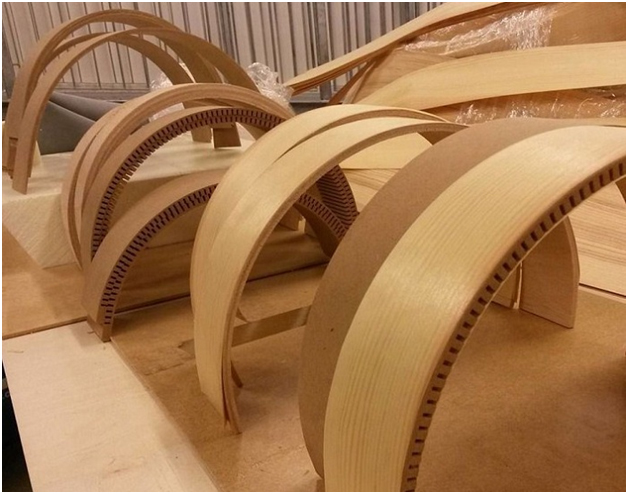 Drying of products takes at least a day
Drying of products takes at least a day
Reasons for using flexion techniques
With the above methods, you can achieve any smooth shapes that will hold firmly after the workpiece dries. This way you can create arches in doorways and rounded corners between walls.But the bending of plywood sheets is especially widely used today in the production of furniture.
This allows:
- Minimize the number of traumatic corners. This is especially true for rooms where children live. Since their restlessness often becomes the cause of dangerous contacts with the corner surfaces of ordinary furniture.
- Increase the aesthetic value of the interior. Because it is much more pleasant for the eye to observe smooth rather than sharp transitions. Sliding surfaces soothe and improve your mood.
- Give more solidity to the object and get rid of the sometimes huge amount of fixing details. This greatly enhances the strength and reliability of the structure.
 Beautiful designs with streamlined lines and no fasteners
Beautiful designs with streamlined lines and no fasteners
Making a "lamellar" stool
Once everything you need is at hand, you can start making a stool with a unique and modern design. In common people such a stool is called "lamellar", because it is assembled from lamellas.
Step 1. Draw on a piece of Whatman paper a sketch of all the details of the future stool. This is not difficult, because there are only two types of parts.
Sketch of future details
Step 2. Carefully cut out the drawn shapes on a drawing paper using scissors. It is not necessary to use Whatman paper for work. The required parts can easily fit on A4 sheets.
Cut templates
Step 3. Transfer the finished templates onto a sheet of plywood and, using a simple pencil, circle them. The number of large parts is 2 pcs., And the number of thin parts is 1 pc. If the dimensions of the plywood sheet are small, then try to place the templates in such a way as to save space.
Transferring templates to plywood
Step 4. Once all the details are drawn on the plywood, cut them out with a hand saw or electric jigsaw. Using an electrical appliance will significantly speed up the cutting process.
The details of the stool are cut
Prices for popular models of jigsaws
Jigsaw
Step 5. The finished elements for the future stool should look like in the photo. To make the cut points smooth, they must be sanded after working with a jigsaw. For this purpose, use a sander or regular sandpaper.
Ready-made elements for the future stool
Step 6. To make it easier to work with the rungs, fold them together and secure with clamps. This will speed up the sanding process. The finished surface should be perfectly flat and smooth after processing. Use a file if necessary (if the irregularities are too large).
The bars are secured with clamps
Elements after grinding
Step 7. Start assembling the parts. Before joining, a small amount of wood glue must be applied to the joints. It will increase the strength of the stool. When assembling, experts recommend using spacers and a rubber mallet.
Assembly of structural parts
Build process
Collecting stool details
Step 8. Make sure that all the parts to be installed are on the same level. Only with maximum evenness will the finished structure look high-quality. This is a crucial stage in the work, so there is no need to rush when assembling plywood parts.
The slats must be on the same level
Step 9. The finished stool looks something like this. After assembly, sand the surface of the product with sandpaper and cover it all with varnish. Once the stool is dry, it can be used. Such a stool looks quite fragile, but in fact it is not.
Finished plywood stool
Another photo of the product
Once the stool is dry, it can be used.
Conclusion
Wood-laminated board is an excellent finishing and furniture material. Lower cost and improved technical characteristics make it a serious competitor to classic wood.And what is especially remarkable, and in no way can a tree boast, it is an amazing ability to bend into the most unimaginable forms, endowing the interior with a special aesthetics. 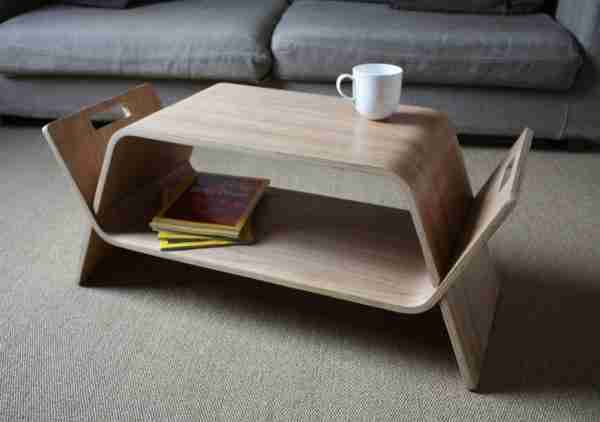
The video in this article will be able to provide your attention with additional information that is directly related to the materials reviewed.
Use materials and achievements of modern technologies!
Plywood can be bent in different ways, if desired, modern machines can provide any shape, from a slight bend to significant fractures with indicators of less than ninety degrees. At the same time, radius products are distinguished into a special group, which have found wide application in various industries. Curved plywood production, which today is widely established in many areas of industry, remains the undisputed leader in furniture and finishing. Radial products have found their application in the technical and decorative areas of the furniture industry, they are also widely used in interior design.
What are curved-glued plywood radius products? First of all, it is the softness of forms and a high practical component, which allows you to simultaneously obtain an attractive appearance, strength, reliability and safety. Not every material manages to combine so many useful qualities at once. Curved plywood production of radius products can be called a relatively simple process. Since, unlike technologically complex options for manufacturing parts with a large number of deformations, radius parts have only one direction of action. Translating from technical language into human, we note that radius products have a given curvature in the shape of a sphere, or rather a part of it. To get such a part, it is enough to have a matrix of the desired shape at hand.
And since bent plywood production has such a simplified form, it is adjusted both as an independent version and as part of production lines. However, one should not think that with its relative simplicity, radius products do not belong to complex industries, because all preparatory cycles here remain the same as in the manufacture of elements with a multi-vector structure.
Bent plywood - production of radius elements for furniture.
As we have already said, radius plywood products in the furniture industry have two directions, in the first case we are dealing with a technical component, and in the second with a decorative one. When it comes to technical details, we mean elements that are hidden from view. Such invisible details include backs and seats of chairs, which, having a radius shape, perfectly provide a given coefficient of stiffness and comfort for the user.
As for the decorative load, here bent-glued plywood shows production in all its glory, and this is an absolutely non-transferable meaning. For a long time, cabinet furniture was of the same type, with straight lines and a minimum amount of decorative elements. Someone liked such a strict geometry, while someone was constantly looking for an opportunity to destroy this boring space. Thanks to the bent plywood elements, it became possible to produce rounded facades, which freed furniture from strict lines, and completely eliminated corners. The furniture was immediately transformed beyond recognition, as its lines became smoother due to the disappearance of strict, limited boundaries.
After that, bent-glued plywood significantly expanded production and began to master new directions in decor. This is how graceful armrests on armchairs, exquisite chairs, as well as rounded corners of door arches, decorations in the form of rounded protrusions and sloping hollows on the walls appeared.But with all this, one cannot speak of the invention of something completely new, because all this once already happened, and the developers simply remembered the experience of their ancestors and gave them a new vision.
Laminate panels, which we simply know as plywood, have found their way into the decoration and furniture production. They have one of the most unique properties they can create almost any bend. Due to this, it becomes possible to create unique aesthetic designs and efficient use of the material.
Now let's talk about how exactly you can make bent plywood
in the industrial production of plywood and independently at home.

